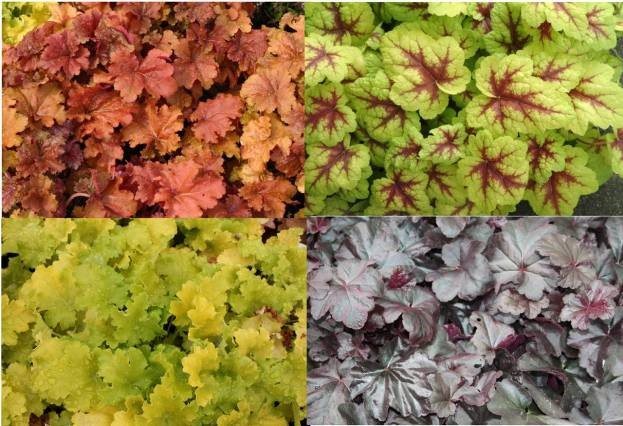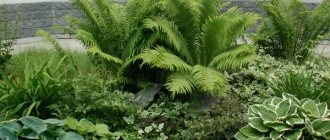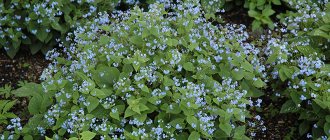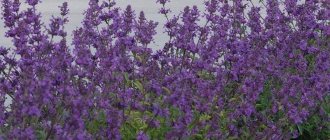Do you dream of flower beds with geyher, but do not know how to arrange them and how to plant them correctly on the site? In the article, we will consider how to plant these plants so that on your future photos the heuchera look as good and beautiful as possible. Geykher is a perennial that flower growers have been planting on their site for many years in a row. The plant has a rich palette of leaf shades.
Note! You can plant such varieties of Heuchers on your site, which can change the color of the leaves several times in one season.
Together with other types of plants, they look much more spectacular. This is especially true for small flowers, usually they are pink, crimson, yellow or white. Such compositions always look great in landscape design. Consider the best options for planting Heuchera flowers in the garden.
Planting a plant
Before planting, you need to choose a location and prepare the soil. Geykhera combines well with other perennials and is not aggressive towards them, so it can be safely planted in a company with other types of plants or a flowerbed made from different varieties of geykhera.
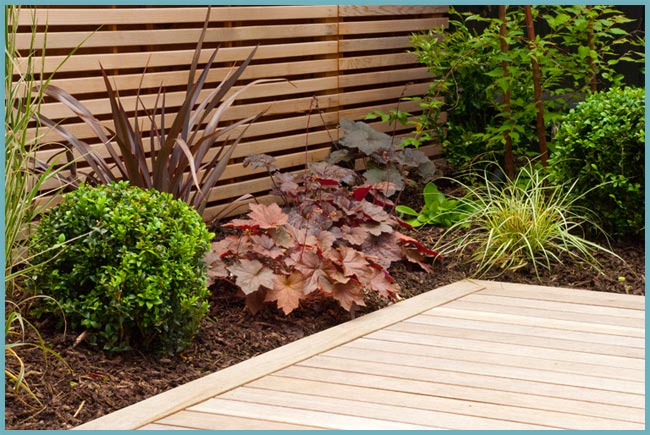
The plant feels great in any neighborhood
The plant prefers light and nutritious soils where water does not stagnate. Acidic soil does not suit her. Before planting, you need to add coarse river sand or pebbles to the soil. Seedlings should be planted in May at a distance of 20-25 cm and watered regularly, but not waterlogged, otherwise the plant may die. Heuchera can be planted in open ground by seeds, cuttings, or by separating the rosette of an adult bush.
Choosing a landing site
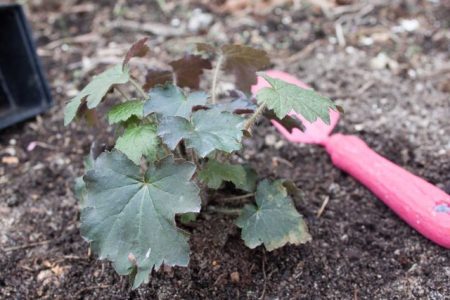

Geykhera is not particularly demanding on growing conditions. But it should be borne in mind that in the sun it blooms better, and in the shade of its foliage it gets more saturated colors. Therefore, when choosing a planting site for seedlings, it is important to prioritize what exactly you want to get from the plant - abundant flowering or bright variegated foliage. It is ideal to plant geykhera in an area where the sun shines before lunch and partial shade appears in the afternoon. Then the need for frequent watering will disappear.
The geography of the location of the crop should take into account the specific variety that will be cultivated. Thus, mountain geychera are less demanding on the composition of the soil and the environment and temperature. They can even grow on sandstone, live in a multi-day drought. In this case, only the color of the leaves will change, but unfavorable climatic conditions will not affect the development of the plant. It is recommended to grow forest varieties on more fertile wet soils. On hot days, they need more water and shade. Red-leaved and bicolor varieties are best kept under the sun, and species with dark foliage are appropriate to grow in partial shade from other tall shrubs.
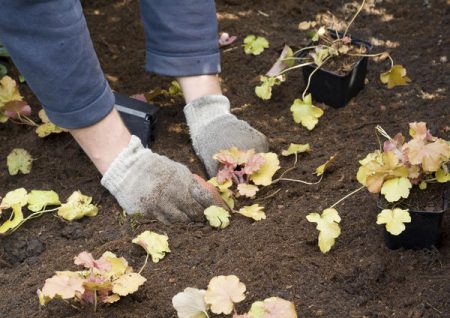

All species absolutely do not tolerate acidic soil and water accumulation at the roots. Therefore, if the land on the site is not suitable for the pH level, then it is preliminarily lime and drained.
Plant care
As for leaving, in this regard, Heuchera is very unpretentious. But there are some conditions, and these are:
- diffused shadow;
- deep drainage;
- permeable soil.
Heuchera, planted in the shade of trees or in partial shade, will retain its decorative effect, since it needs the sun in the morning.It is worth planting varieties with red leaves on sunny areas, it is in the sun that they will turn red, but in the shade they will remain green. But many varieties adapt to the sun - the silvery mosaic of their foliage takes on a richer color, and the heuchera with purple foliage darkens.
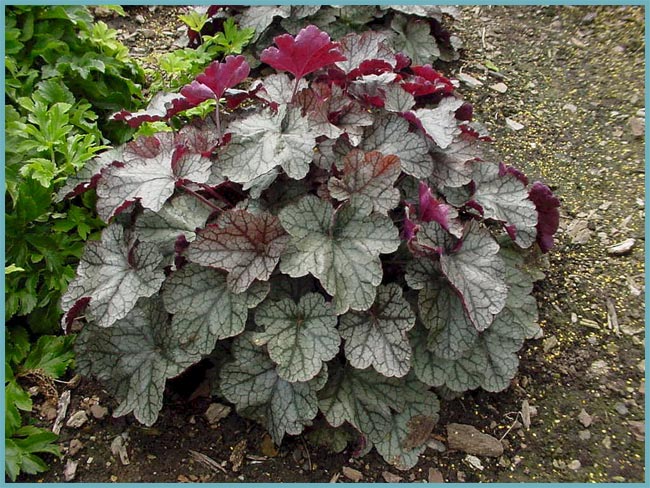

In the shade, heuchera leaves will acquire rich shades.
The root system of Heuchera is shallow, so it is important to protect the roots from drying out. It is best to apply mulching. Mulch will retain moisture, the soil beneath it breathes and is structured by soil inhabitants. As mulch, you can use straw, sawdust, compost, tree bark, foliage, expanded clay screenings, gravel, peat.
The soil must be permeable - the plant can get sick and die from stagnant water. Therefore, you should take care of drainage even when planting a plant.
Aging heuchera bushes lose their decorative effect - the middle of the bush is exposed. In this case, you need to rejuvenate the bush: dig up the plant, divide it into parts and plant it. This should be done in late summer after flowering or in spring before the leaves open. Heuchera tolerates these manipulations painlessly and immediately starts to grow.
Soil mulching will help Heuchera maintain moisture balance
Dried foliage is not removed in winter - it helps the plant to overwinter, covers the roots and retains heat. Remove only inflorescences with seeds - after flowering, they spoil the decorative appearance. In the future, the collected seeds can be used for propagation and cultivation of Heuchera in the open field. Varieties with light foliage and young bushes for the winter need to be additionally covered with foliage.
Advice. Water the plants early in the morning or in the evening, drops of water in the sun can burn the leaves.
Heuchera and shade-tolerant plants
As mentioned earlier, Heuchera is a perennial plant that loves shade and partial shade. Therefore, it is better to plant this flower next to shade-loving plants. Host or fern will become excellent neighbors for a heuchera flower. And it doesn't matter what kind they are. Absolutely all are suitable.
Dicentra will also keep this plant a good company. However, it is planted if you like flowering plants. And do not be afraid, the beauty of these two species will not harm each other in any way, if you adhere to a certain rule for combining colors. The dicentra looks great with geyher only if their flowers are purple, burgundy or purple.
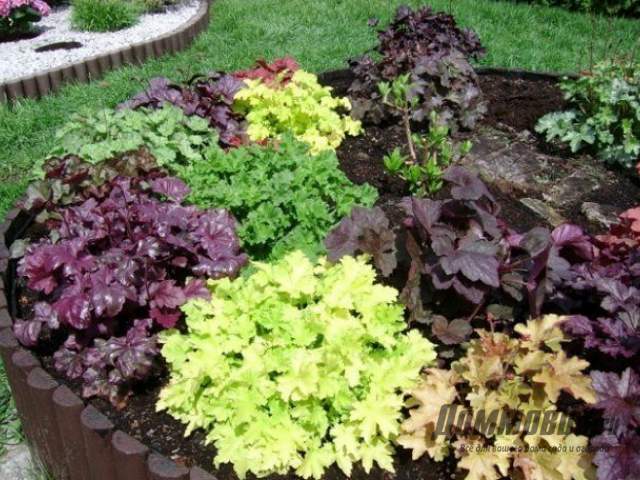

If you planted a pale salmon-colored Heuchera, then you can place cute blue forget-me-nots next to it. Anyone who loves large-scale plants and flowers should not despair either, as the designers have come up with an excellent solution for them. Heuchera flowers are planted at the foot of tall daylilies and beautiful lilies. It is better to plant a flowerbed in this style not far from the walls of a country house, in this case it looks much more spectacular.
Fertilizer and feeding of Heuchera
Before being domesticated by man, Heuchera grew in the mountains, where the soil is rather scarce. Modern varieties are still not far from their wild relatives, so they do not complain about the small amount of nutrients in the soil. Mineral fertilizers are rarely used. Better to limit yourself to one dressing in the spring in the first year after planting. If you did not do this in spring, then feed Heuchera with mineral complex fertilizer for deciduous plants at the end of the growing season. After fertilizing, be sure to water the bushes.
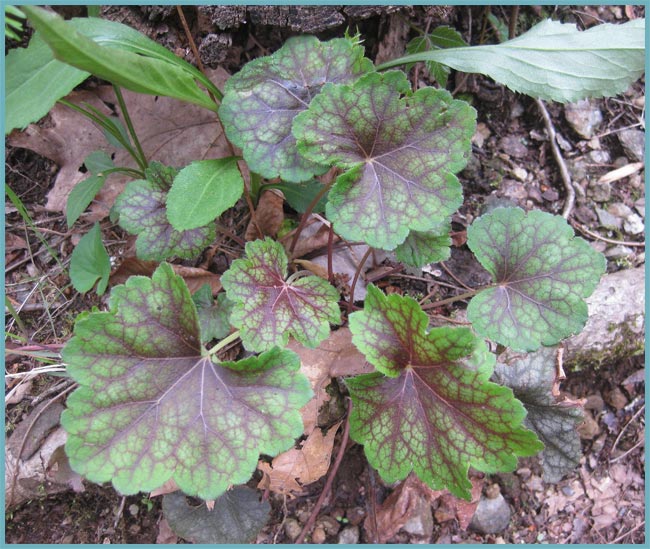

There is no need for regular plant feeding
Important. When applying fertilizers, be sure to halve the dose recommended by the manufacturer on the package.
Types of Heucher
The pedigree of the plant is not too large and has about 400 species and varieties, differing in places of growth, height of bushes, texture and color of leaves, shape of flowers, flowering time.All types of geyher are divided into forest and mountain ones, since in Mexico and the mountainous regions of America they can be found in forests and woodlands. And in landscape design, only a tenth of all known varieties are used.
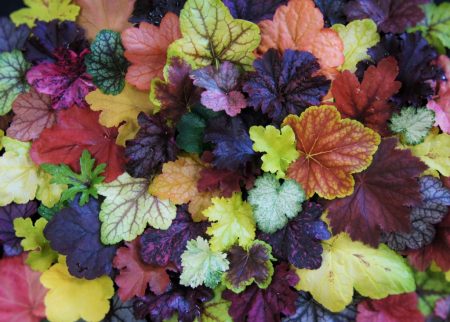

Heucheras are divided into two types:
- Decorative deciduous - plants with large variegated leaves.
- Ornamental flowering - shrubs, the main decoration of which are flowers growing on long peduncles.
Heuchera blood-red Heuchera sanguinea
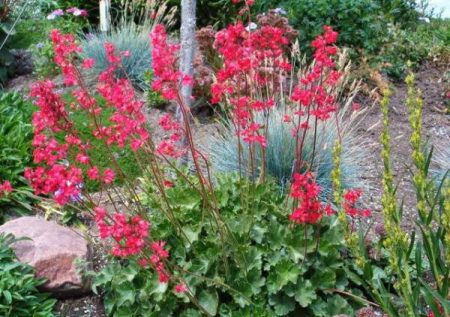

It was the blood-red Heuchera that became the basis for the creation of dozens of varieties used today in garden decoration. The mountainous type of Heuchera was found in Mexico. Improved varieties have more powerful stems and branched inflorescences.
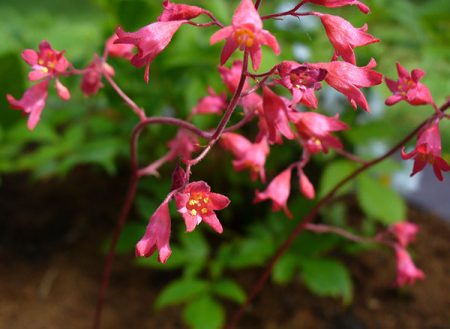

A distinctive feature of all varieties of blood-red geyher is tough, dense leaves of green color (less often you can find silvery, cream, white foliage shades). The shape of the leaf plates is round, with pointed edges. Red or crimson small flowers, collected in panicle inflorescences, give a special charm to the species. Separately, the flowers are similar in structure to bells. So it seems that the wind will blow and they will ring in the whole area.
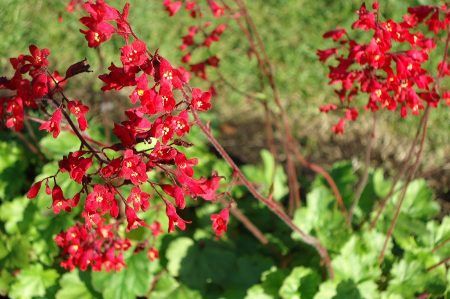

By the way! The blood-red heuchera is also called the "coral bell".
The plant of this species belongs to undersized plants. The maximum height of the bush barely reaches 40 centimeters. It looks impressive as erect peduncles protrude high from the dense green crown, the ends of which are hung with numerous flowers. Native to the American foothills, Heuchera has a potent immunity to disease and pests. She firmly endures cold and summer heat. Can grow unquestioningly in the shade, in a well-ventilated area. Even to the composition of the soil, it is unpretentious. The main thing is that the soil is well drained - Heuchera does not tolerate strong moisture.
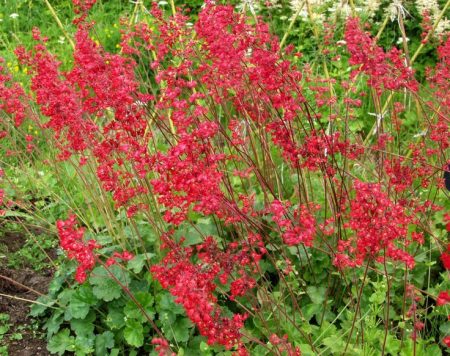

Reference! According to some reports, the Indians in the old days used the red flowers of heuchera to treat many diseases. It is believed that the mere presence of the plant in the home contributes to the health of all family members.
This species is represented by the following varieties: Alba, Mone, Robusta, Hercules, Splendens, Snowstorm, Variegata, Splish-Splash, as well as the Bressingham Hybrids varietal group.
Heuchera American Heuchera americana
Another magnificent representative of the Heucherov family. In the wild, she lives in the foothills in the north of America. You can also find it in the undergrowth next to ponds and lakes. Flowers the plant forms mediocre: they are pale yellow, rare and unsightly. They bloom in early June and bloom almost until the end of summer, thinning the wondrous aroma of the entire district.
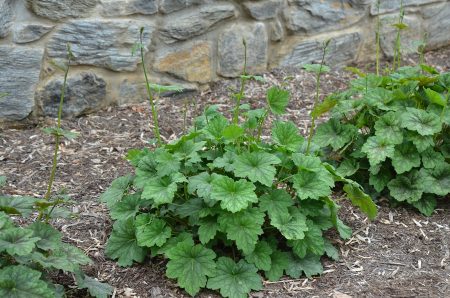

Foliage is a completely different matter - this is the main advantage of the American woman. Long erect shoots are decorated with large serrated leaves of a round-heart shape. The base of the leaf plate is green. The standard color is diluted with whitish stains and spots, purple streaks. The underside of the leaves is completely lilac colored. There are varieties with green leaves decorated with a red border.
The most spectacular of this species is Green Spice.
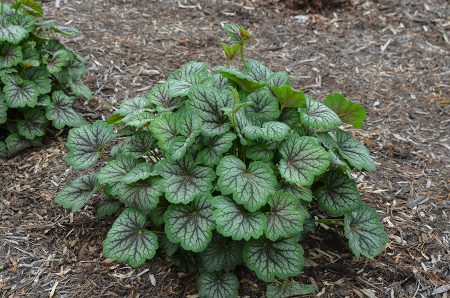

Heuchera hairy Heuchera villosa
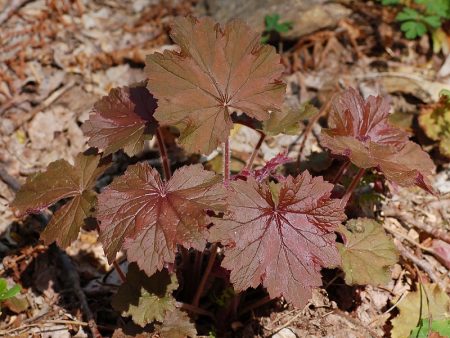

A view that is not often used in landscape design, but it still deserves the attention of decorators for its many advantages. The height of the hairy geyher reaches a limit of 45 centimeters. The foliage is large, maple-shaped, has a greenish-bronze color. The petioles are short, pubescent. Hairy (hairy) peduncles rise high above the green crown, forming voluminous paniculate inflorescences, in which numerous pale-faced flowers of a pale pink, greenish color are collected.
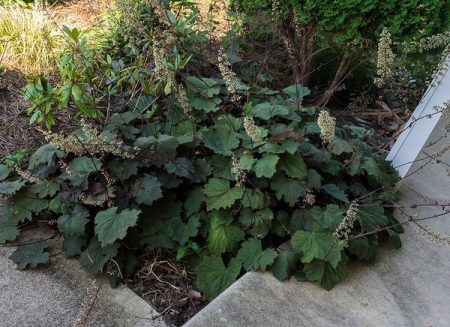

A striking variety of hairy geyher is the Bronze Wave cultivar. The plant is characterized by the beauty of its leaves: they are large, corrugated, have a small pile and are painted in bronze, coral, beige and orange. The shrub blooms from June to August with delicate creamy flowers.
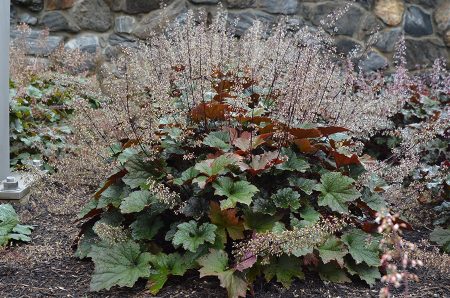

Reference! In their natural environment, hairy species can be found in the Mississippi River Valley.
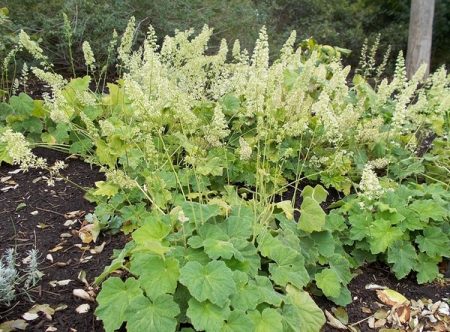

Hairy shrubs prefer moist, fertile soils and shaded areas. On the basis of such "unpretentious" data, scientists have created varieties suitable for cultivation on the territory of our country.True, they differ in the color of their foliage (more often it is purple, light green, apricot), but keeping them in your garden is not difficult at all, since they require almost no care.
Heuchera cylindrical Heuchera cilindrica
The species mountain geychera received this name for its high peduncles (up to 90 centimeters) and large flowers formed on long peduncles, which are collected in the likeness of cylinders. The inflorescences are dense, dense, there are a lot of them on the bush. The flowers sit on short stalks, have different petal colors - from pink to yellow-green, depending on the variety. The leaves are rounded, in the form of a heart. Most often they are green with dark veins and a silvery sheen.
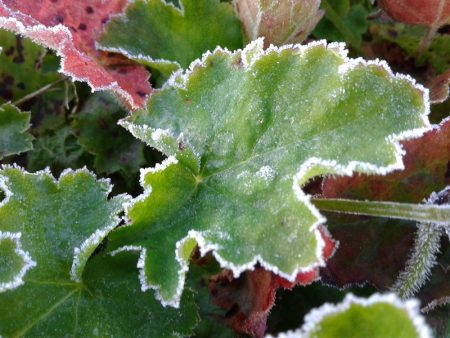

Cylindrical crop species gravitate towards loose light, fertile soils and medium illumination. The most popular varieties of cylindrical heuchera: Hyperion, Greenfinch.
Heuchera hybrid Heuchera hybrida
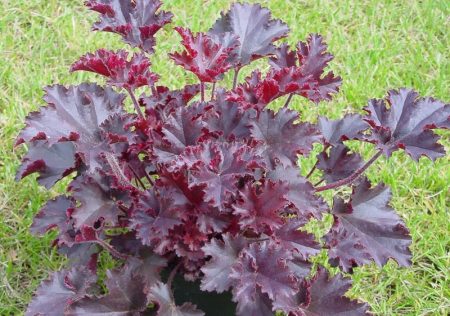

The variety of these heucheras was bred by multiple crossing of the American, small-flowered, hairy species. Thanks to their work, varieties with longer and more abundant flowering (up to 3 months) have appeared. The plant forms a small bush 50-60 centimeters high. The leaves of hybrid varieties are larger, of any color (usually green) and textures, with or without patterns, embossed and simple, corrugated and semicircular.
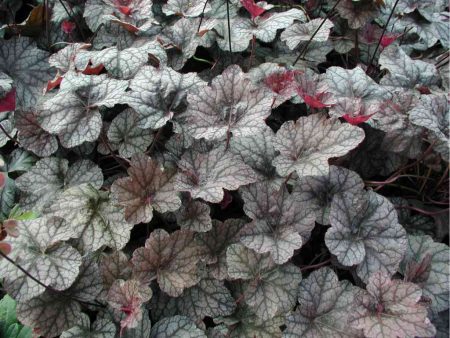

During flowering, small bell flowers of pinkish shades appear on the stems.
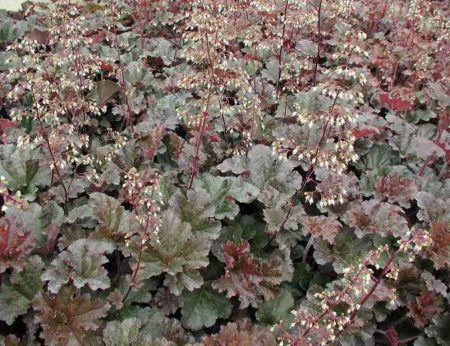

The type of hybrid geycher is called quaggy. The disadvantages of this variety include frequent shedding of inflorescences during the wind. The best varieties: Cappuccino, Ruby, ValeCancan, Beauty Color. The most famous variety is Can-Can, which has won many exhibitions due to the presence of corrugated burgundy leaves with silvery spots.
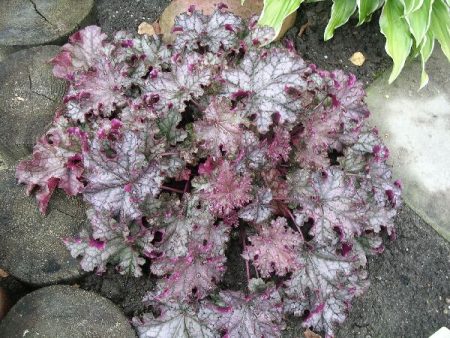

Gooseberry Heuchera Heuchera grossulariifolia
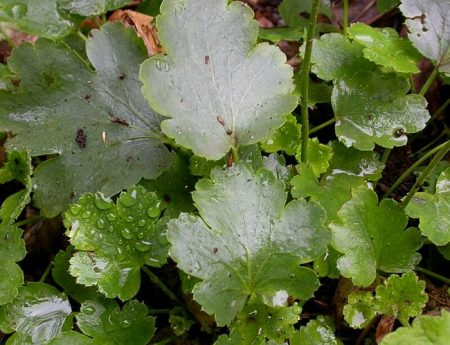

A very popular variety in Russia. Low-growing bushes are overgrown with small wedge-shaped leaves up to 7-8 centimeters in diameter, from the thick of which long 30-40 centimeter peduncles rush upward. Their ends in the middle of summer are decorated with small inflorescences of large white flowers.
All varieties of gooseberry-leaved geyher have amazing winter hardiness, strong immunity to diseases. For these qualities, Russian gardeners living in the middle zone of the country love to plant it.
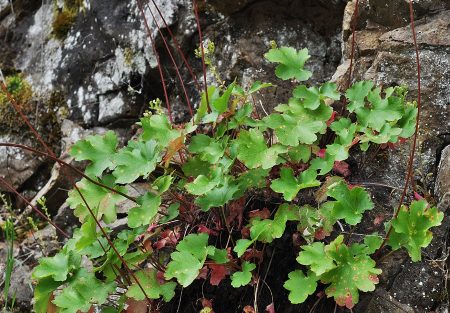

Heuchera small-flowered Heuchera micrantha
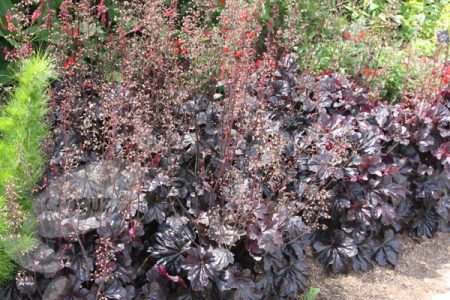

The plant variety is considered the most spectacular among the culture. Small maple leaves have a very different color, which makes the bush colorful, playful. Some varieties are painted in bronze, others in purple, and still others can be cast in silver. The flowers, as well as the leaves, are small, velvety. They are usually creamy, pink in color with orange anthers. Plants grow well on moistened organic soil.
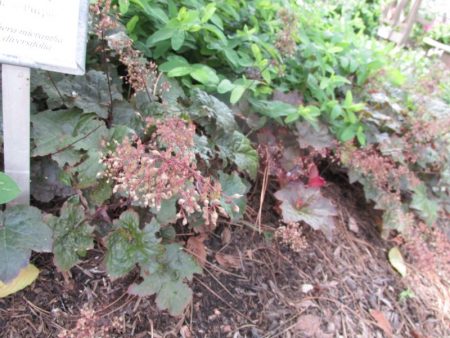

Palace Purple is recognized as a popular variety of small-flowered heuchera. The plant is not capricious, winter-hardy. Grows well on slightly acidic soil.
By the way! Palace Purple was known as the most popular perennial among ornamental plants in the 90s.
Caramel
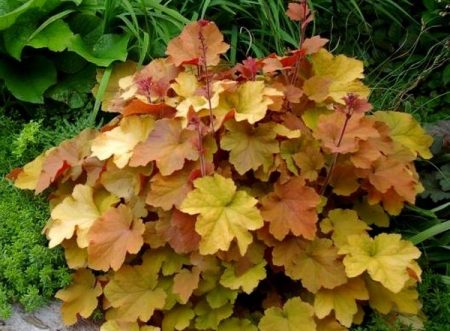

This “sweet” name was given to this variety of geyher due to the caramel color of the foliage and its voluminous texture, which, it seems, can be bitten off and it will taste sweet.
Caramel is a very common varietal plant. It is popular because of the openwork carved leaves, painted red at a young age, and when they mature, they acquire golden, amber tones. Redness remains only on the underside of the leaf plate. During flowering, small cream-colored flowers appear on the peduncles.
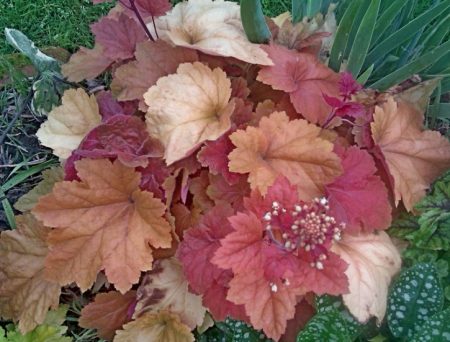

The bush grows and develops very quickly, it is capable of growing a voluminous dense crown in one summer, which looks especially beautiful in a flower garden after rain, when the foliage is strewn with shiny drops of water, similar to melted sugar. Caramel Heuchera is not afraid of cold weather. The variety is willingly used by decorators of garden plots to create colorful, multi-textured compositions.
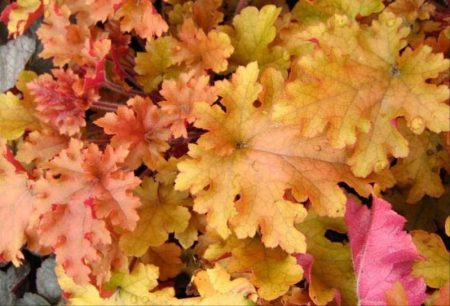

Marmalade
In summer, the bush is similar to the autumn one, that is, the foliage is painted in yellow-green tones, as if the plant is preparing to remove old foliage. This combination of colors gives the garden a romance and melancholy.
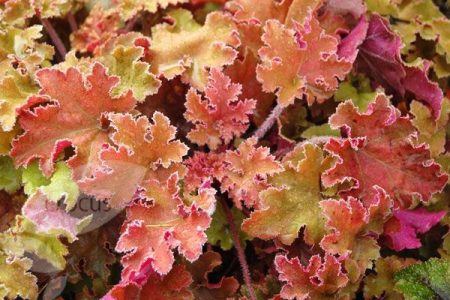

By the end of summer, the foliage gradually turns into a fire hat, the top of which is decorated with small numerous mediocre pale pink inflorescences. The plant blooms in early summer.
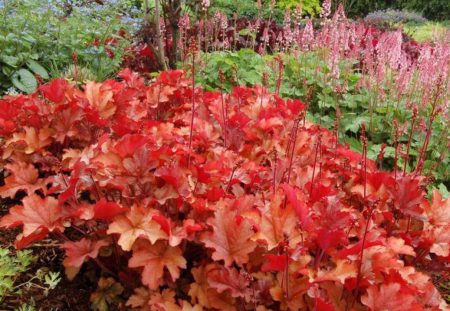

The foliage changes color from spring to autumn, and remains very decorative all this time.
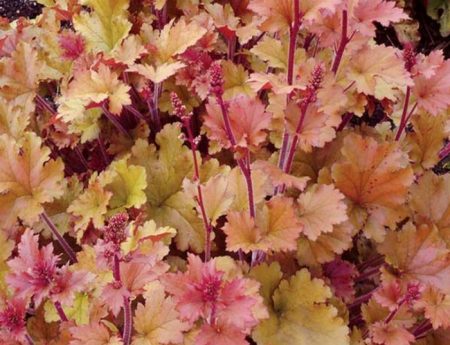

Geichera Cherry Cola
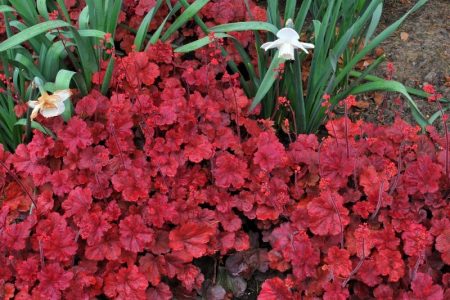

An incredibly delicate undersized plant that can be planted along the bottom row of a flower garden, along curbs or grown in hanging pots. The height of the bush hardly reaches 20 centimeters. The plant grows very slowly, smoothly, without hurrying anywhere, and encouraging to admire its graceful forms for as long as possible. The variety is characterized by rounded wavy foliage, which with age changes its matte color from orange or red to yellow or green gloss. Red or "salmon" inflorescences are located along the entire length of brown peduncles.
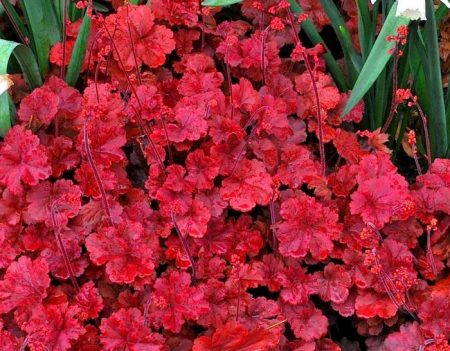

Advice! Due to its small stature, an incorrectly located Cherry Heuchera on a flower bed can get lost. Think about this when creating a floral arrangement.
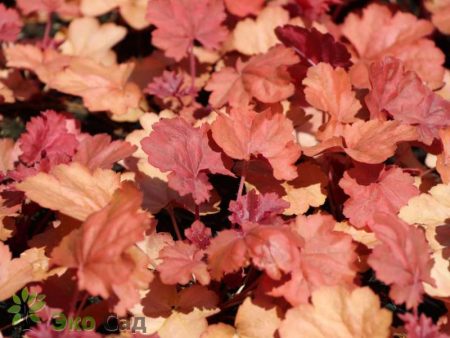

Purple castle
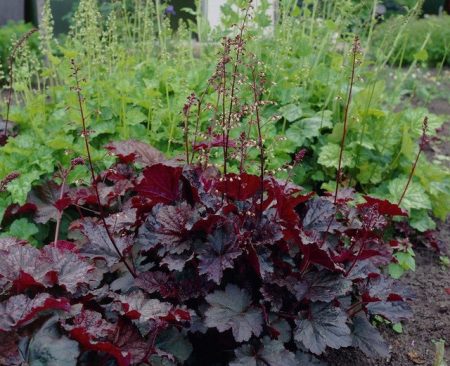

The variety belongs to the group of small-flowered Heucheras. Released in 1980. The structure is similar to ivy. Plants of this variety have the ability to multiply rapidly due to the large number of branched rhizomes. Due to this feature, the Purple Castle is loved to be used in curb compositions and planted along paths.
Textured bushes in rock gardens look great. Many small buds are collected in panicle inflorescences. They are mainly colored beige, which is atmospheric combined with purple leaves. The originality of the color of the foliage (purple, burgundy, violet) makes Heuchera indispensable in any flower bed. Plants by their presence are designed to slightly muffle the brightness of colors of other colors. The Purple Castle looks good in single plantings or in combination with other plants such as geranium, hosta.
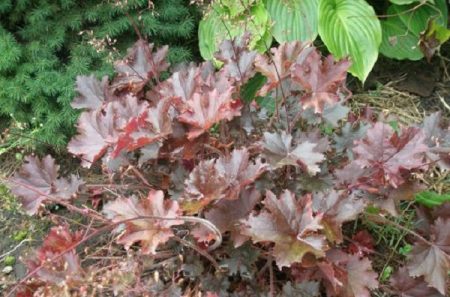

Black bird
A very showy variety. The crown of the shrub grows 50-60 centimeters high. Long rigid peduncles rise above it by another 20-30 centimeters higher. The foliage is tough, rough, pentagonal. The real highlight of the variety is its color - it is dark burgundy, almost black. For the similarity of large dark leaves with a raven's wing, the variety was named so. Dilute the "blackness" with voluminous loose cream-colored inflorescences.
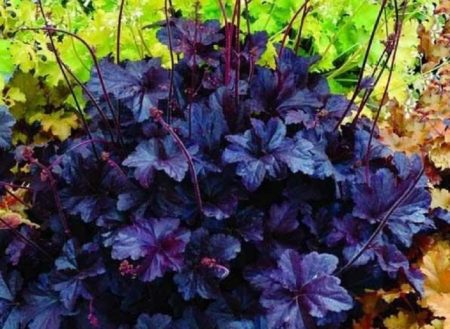

Black bird plants are ideal for growing along paths.
Plant propagation
Reproduction by dividing the bush is the simplest way, which preserves the decorativeness of the variety. This is done in early spring or autumn. Separate the rosette from the adult plant and transplant a little deeper than the mother plant was planted.
The second way is grafting. A 4-6 cm stalk is cut from the bush in the summer and rooted in a greenhouse. The process takes 3-4 weeks, after which the finished plant can be planted.
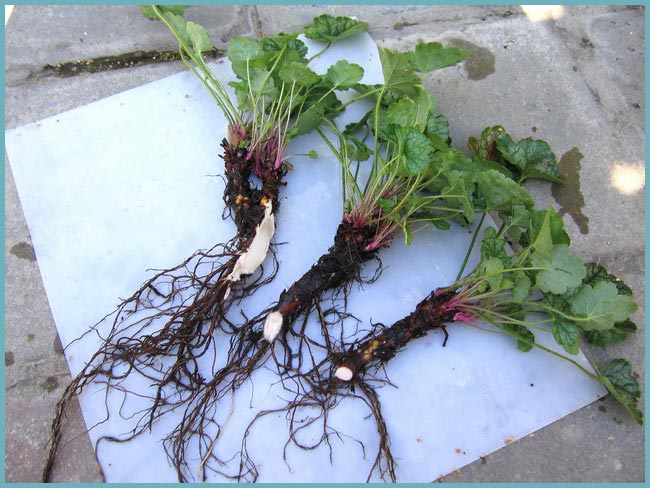

Division of the heuchera bush
Varieties
Before planting and caring for a perennial geyhera, you need to choose the right variety that would fit into the flower bed and become an important component in it. Of course, you need to consider how leaves and peduncles are combined with other flowers.
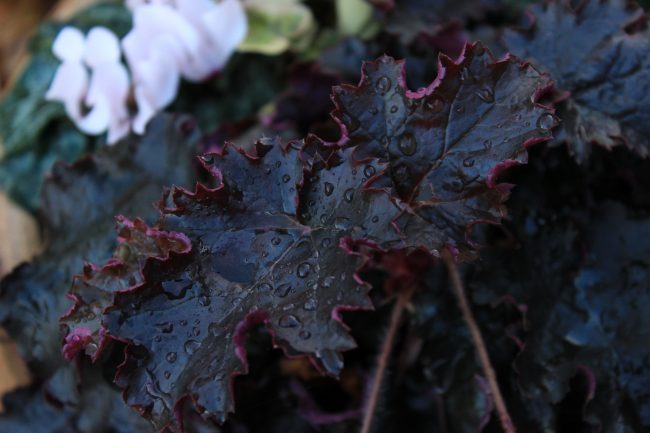

Very beautiful deep dark burgundy color of the leaves. This geyhera will become a highlight of almost any composition.
Popular varieties:
- Alba. Flowers 40-50 cm high, appear in mid-summer and remain on the stems until autumn. The foliage has a bright green color, the flowers are white.
- Robusta. The height of the flowers is 40-50 cm, they are dark red, rather large in comparison with other species. Will delight you at the beginning of summer. The leaves are green, but change to red as the season progresses.
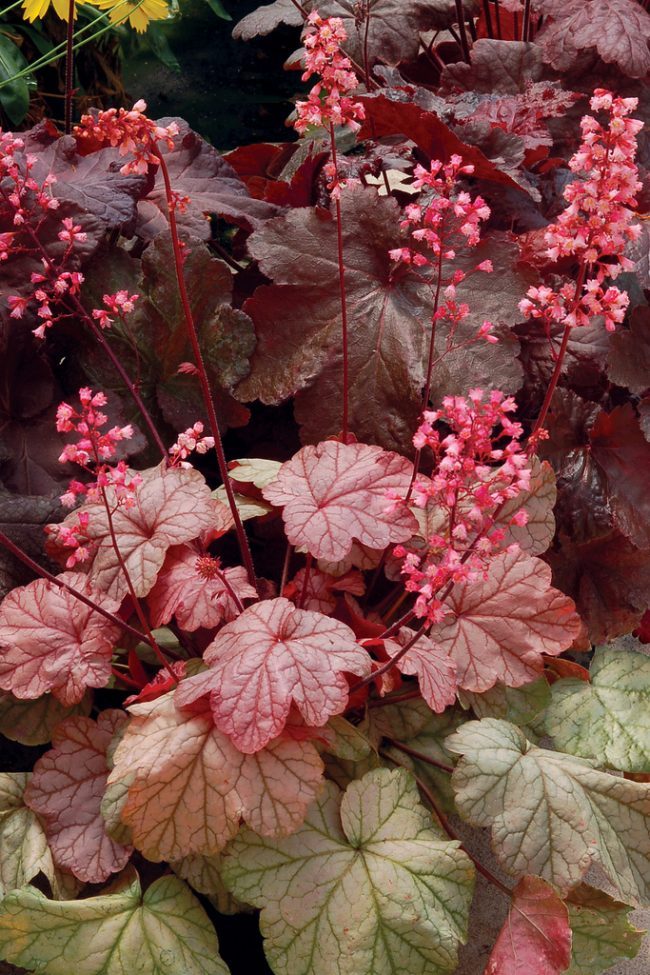

On a bush of this variety, you can observe leaves of different colors and shades during the period of changing the palette.
- Snow storm. The flowers are not very high from the outlet, only 30 cm, they have a bright red color, which appears at the very end of autumn and early summer.Leaves are variegated - white-green. Despite its appearance and name, it does not differ in winter hardiness.
- Splash. Flowers are located at a height of 30-40 cm, pink. Blossom in early summer. The leaves in this variety attract more attention than flowers, they are very noticeable: the base is green, there are light green spots along it, the veins are crimson-red.
- Purple castle. Flowers bloom at a height of 40-50 cm, delight with their white color from mid-spring to the very frost. The leaves are purple with a metallic sheen.
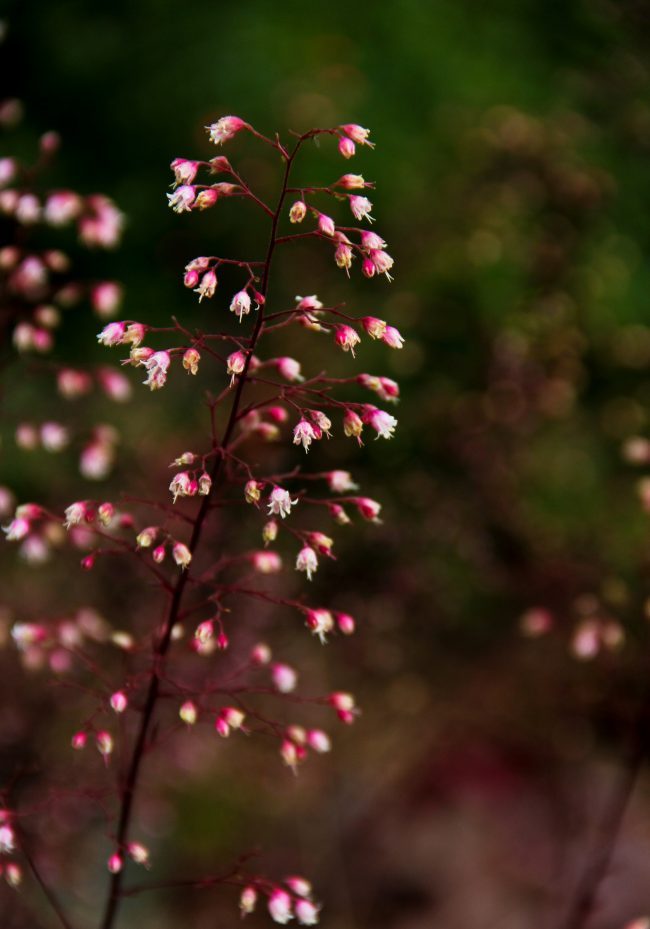

Small flowers on the flower stalks of Heuchera varieties purple castle are white with a pinkish accent on the receptacle
- Cappuccino. The height of the inflorescences is up to 50 cm, the color fully corresponds to the name of the variety, it pleases in the summer - a couple of months. The leaves are mostly green, there are veins with creamy splashes.
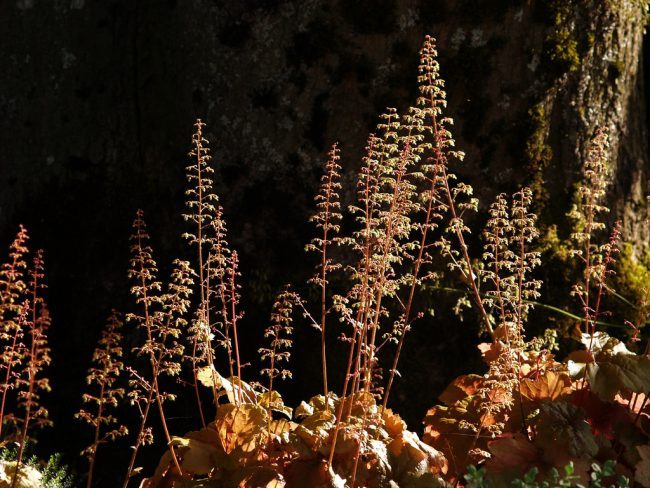

Heuchera cappuccino varieties during flowering
- Rachel. Delicate pink flowers bloom in summer, the leaves are bronze-purple.
Diseases and pests
As for diseases, Heuchera is unique in that it practically does not get sick in the open field, and is rarely affected by pests. But sometimes it can suffer from powdery mildew, rust, gray mold or leaf blight. This can happen if the plant is frequently watered, or the soil is poorly drained and the water stagnates at the roots, creating an ideal environment for pathogens to thrive. From an excess of fertilizers, the plant "fattens", which leads to a weakening of immunity. Powdery mildew can be defeated by spraying with a fungicide, after removing diseased leaves, and the Bordeaux mixture will cope with spotting and rust.
Rust on a Heuchera leaf
As for pests, the danger to the plant is posed by the beetle larvae, which can gnaw at the roots, grape snails, slugs, caterpillars and leaf nematodes, which can be removed with an insecticide.
Advice. Slugs hide in secluded places from the sun during the day, so you can put a board, slate, cardboard or a piece of old linoleum near the heuchera, and collect slugs under them in the morning.
Views
There are a lot of plant species, but not all have received recognition and popularity, here are the most popular ones:
- American. The height of its deciduous rosette is 15-20 cm. The leaves are heart-shaped, the underside is brownish. Flowers - light green.
- Hairy. The leaves are large, velvety, pubescent cuttings. The flowers are small, green.
Hairy heuchera with large, like fluffy velvet leaves
- Blood red. One of the most popular types. It showed itself excellently in the middle zones of our country. The rosettes of the leaves are compact and dense, their shape is rounded. The leaves are pubescent toothed. Flowers are small bells. Their color ranges from terracotta, crimson to red.
The leaves of this species are not so large, but still not inferior in beauty to the previous one. Its main advantage is the deep, rich red color of the plant.
- Hybrid. A cross between American and blood red. The leaves and flowers are larger than those of the first species. It blooms for a long time and abundantly.
- Small-colored. The foliage has noble gray-silvery spots. It has high decorative properties due to inflorescences. They have a paniculate shape, the color of the flowers is cream with red anthers.
- Cylindrical. It has rounded beige-green flowers. The leaves are also green, shaped like a heart, the edges are jagged, the veins are contrasting.
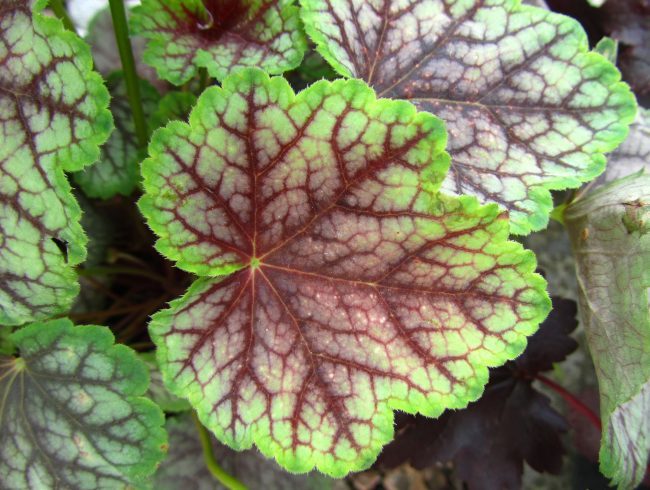

Neat small leaves of a cylindrical heuchera are distinguished by a contrasting color: for example, it can be a combination of bright green with maroon
- Gooseberry. Differs in increased winter hardiness, even after severe frost it remains invariably beautiful.
Planting and caring for Heuchera (see photo) of any kind is the same, and retains its decorative properties for most of the year.
Heuchera: combination with other plants
Thanks to the contrasting combination of heuchera leaves with the leaves of other plants, you can create unique compositions.Geuchera is planted with hosts, kupen, ferns, hellebores, daylilies, combined with decorative cereals, bruner, irises, barberries.
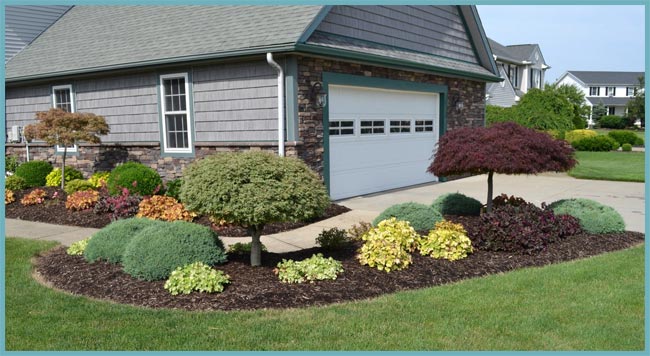

Heuchera will decorate your garden even in autumn, when other plants have faded
Heuchera goes well with tall conifers, acts as an addition for short roses. In spring, it is good to place with tulips: after they have faded, the flower bed is not empty.
Planting geychers on an alpine slide
These plants look great in the foreground of the rock garden. It's not worth repeating their neighbors again, since all those flowers that were listed earlier can complement a flower garden with geyher and on an alpine hill. Only cereals should be noted separately.
Naturally, these are far from all the options in which geychers play the main role. Pay attention to these recommendations for combinations of plants and flowers, which were disclosed in this article. But try to create your own design ideas that can make your garden look chic and unique.
Geichera in landscape design
Do not be afraid to experiment with planting Heuchera in your area. Like precious stones, Heuchera will decorate any flower garden; no other flower culture has such a rich palette with an abundance of colors and shades.
A huge advantage of Heuchera is its decorative effect during the entire growing season and ease of maintenance. Heuchera is grown both in single plantings of the same species, and in mixed ones, used as a perennial ground cover plant. With its compact bush shape, Heuchera is an ideal companion to combine with other plants. This is a real find for those cases when you need to fill the space in the flower garden or highlight the dignity of another plant, highlight the planting of conifers.
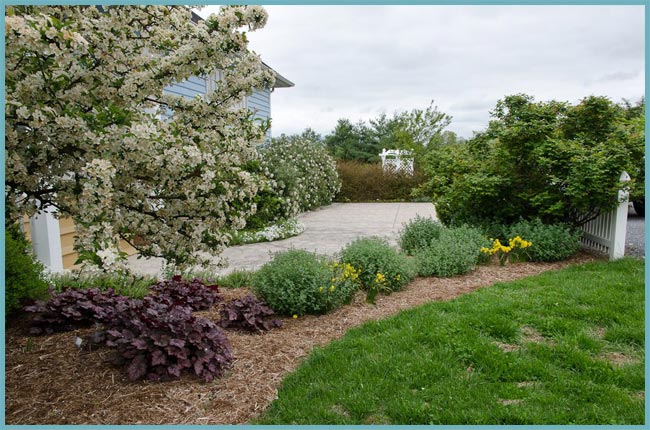

Geichera in landscape design
Geykhera does not lose its decorative shape with age, therefore it will ideally fit into flower beds of strict geometric shapes, mask unsightly areas. Geichera is suitable for creating alpine slides, rocky gardens, borders, decoration of terraces and gazebos. She can decorate garden sculptures, slides and fountains. Often used for planting in ceremonial flower beds.
In the first year after planting Heuchera, it will be difficult to assess its merits in landscape design - just planted, it will not yet become such a magnificent beauty, but already in the next season you will be able to enjoy the density of colors.
Solitary plantings
Single plantings for these plants are not new or wild. In fact, it is in such plantings that flowers look much more beautiful than when they are massively planted with other plants. At the same time, pay attention to the varieties of varieties of the Heuchera flower and try to rationally and correctly combine the shades of their leaves and inflorescences. Do not forget that in a flower bed, they should be in harmony not only with each other, but also with the rest of the landscape design as well.
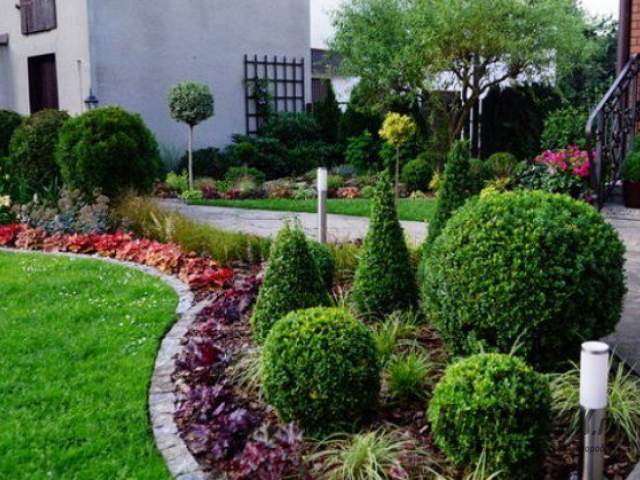

You can create a small flower bed with plants of this flower in contrasting shades. It will intertwine dark-leaved (for example, burgundy or purple) and too bright or light flowers (for example, lemon, yellow or golden).
Also, a good option is to create a flower garden from heuchers of the same shade of inflorescences, but with a different texture of foliage. A flower garden with a smooth transition of shades also looks good: when light plants are replaced by flowers a little darker, then they turn into a different shade, and the flower bed ends in a black or maroon shade.
As an excellent bright accent in the garden, Heucheras are suitable for decorating ridges or garden borders. You can also plant plants along paths or paths, the plants look especially impressive if you made the paths yourself.
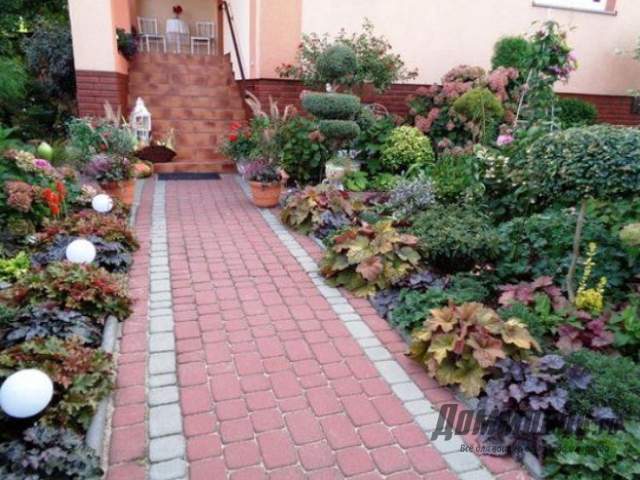

Note! Heucheras are of short stature, they will not be able to grow in too sunny territory, so deciduous trees can be planted next to them, which will form the shade necessary for the flowers. Ornamental shrubs or grasses are also suitable for this purpose.
Also, do not forget about fashionable trends in garden design. Today, not only high beds with different vegetable crops are popular, but also similar flower beds, on which heucheras of various types of shades will look great.
Geichera: photo
Reproduction
Planting and caring for Heuchera in the open field provides for its reproduction and it is important to keep it under control. In order to create an attractive look for the flowerbed.
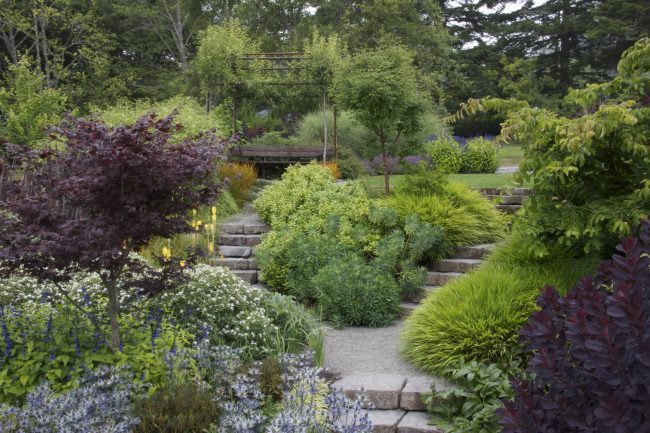

Very cozy backyard of a private house with interesting compositions of ornamental plants
Breeding options 2:
- Seeds. They form in a capsule, which is the fruit of a flower. Since the seeds are very small, they do not need to be buried in the ground. A slight indentation is sufficient. Thus, it is better to plant it at home. Optimally at the end of autumn, then in the spring you will get a developed plant, ready for transplanting into open ground.
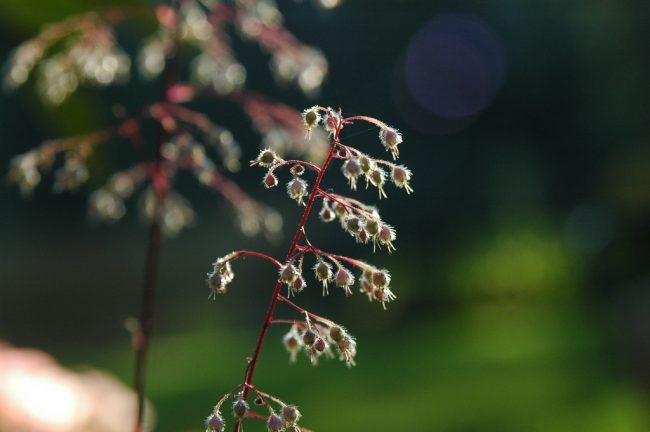

After the flowering of heuchera, small boxes with seeds are formed on the peduncles, which you can use to propagate this plant.
2. Cuttings. So it is better to get new plants from Heuchera until the flowers appear. And it depends on the variety growing in your flower bed. If you did not manage to do this before flowering, then it is allowed to carry out cuttings in July.
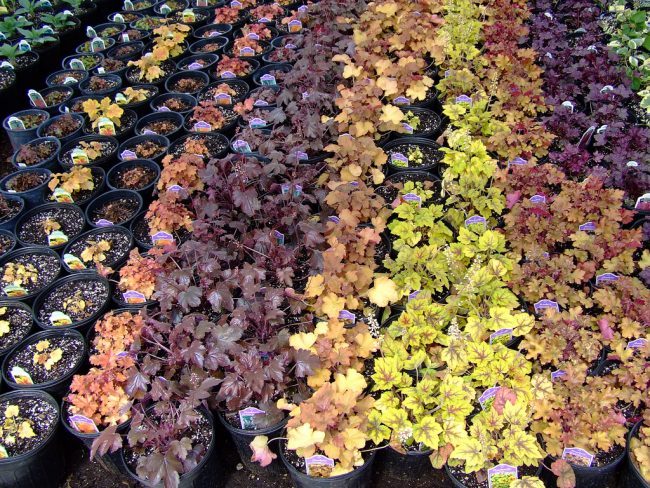

Seedlings of young Heuchera plants
Growing features
Before settling this beauty in your garden, you need to know some features, plants, namely:
- in ornamental plant varieties, peduncles must be removed immediately after flowering;
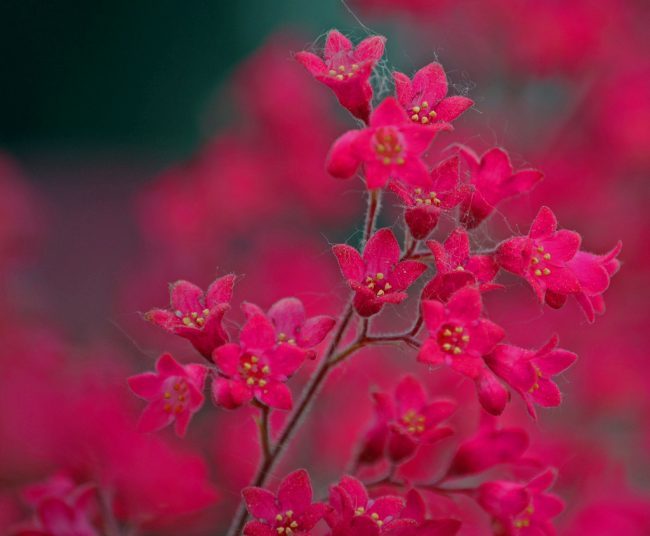

Since heuchera flower stalks can reach up to 50 cm, after flowering it is better to cut them off so that dry stems do not spoil the appearance of the bush.
- during the season. The lower leaves dry up and fall off. In order for the Heuchera not to lose its decorative properties, before flowering it must be planted in a deeper hole, then the bare trunk will not be so noticeable;
- when heuchera is young, its delicate leaves are almost transparent and very bright, as they grow, they thicken and become darker;
- the compatibility with other ornamental plants is excellent, best of all with astilba, daylily, primroses, incense and ornamental cereals;
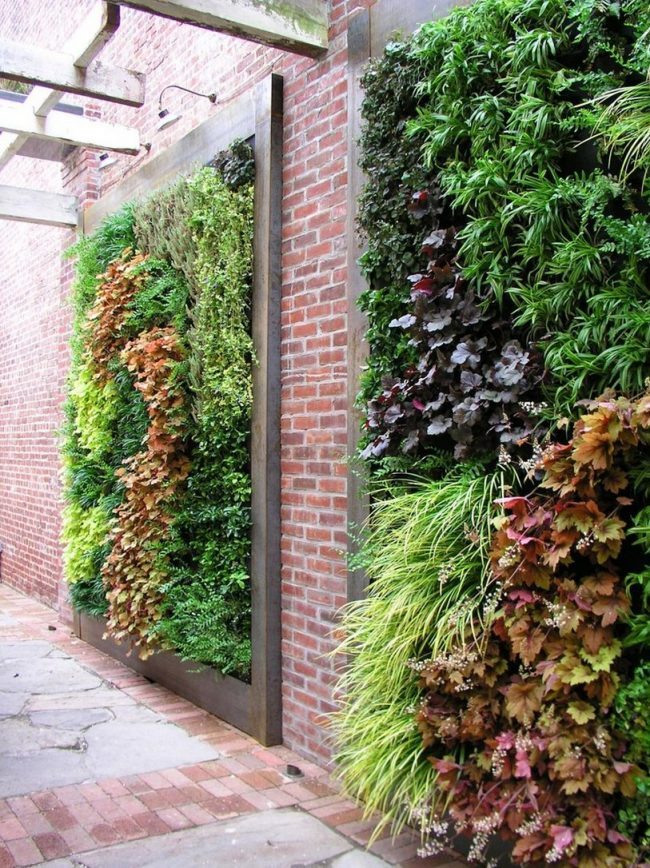

An unusual choice for decorating walls using an original solution to arrange a composition of various decorative bushes
- you cannot cut the leaves for the winter, because the plant is always green and any manipulation of the leaves or stem can lead to its death.
Growing and care
Heuchera is distinguished by relatively low requirements. Taking care of them is very simple. In winter, the plants do not need to be covered, they are frost-resistant, they grow in the Moscow region and the middle lane. In snowless winters, it is worth covering the bushes with needles.
Watering
If the plants grow in a sunny location most of the day, they should be watered regularly. However, constant high humidity causes fungal diseases - it should be watered often, but in moderation.
Transfer
Sometimes the bushes have to be transplanted. Heucheras are durable and can grow in one place for several decades. However, over time, they can begin to thin out - the inner leaves slowly die off, the bush loses its aesthetic value. In this case, transplanting Heuchera to another place can help.
If the plant is very large, there is no need to dig it up completely. Only part of it can be transplanted. Separate the selected part from the mother plant with roots, clean the dead leaves and plant in a new place, pressing the soil tightly around. Planting distance - every 20-30 cm. Planting depth - the same as they grew before. Young seedlings are watered once a week.
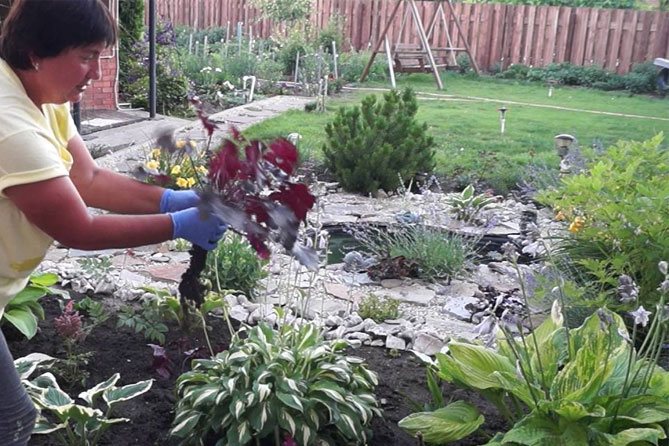

Pruning
These garden flowers need pruning. Pruning is done in the spring, preferably before the beginning of the growing season, you need to remove old shoots, making room for new growth. Then the plant can develop faster and recover well. This evergreen perennial is not always frost-resistant, so it can freeze slightly and recover for a long time after winter. For guaranteed overwintering, you can plant it in a pot and in a hole in the ground. Then the perennial will grow more slowly, but it will become more resistant to disease, frost.
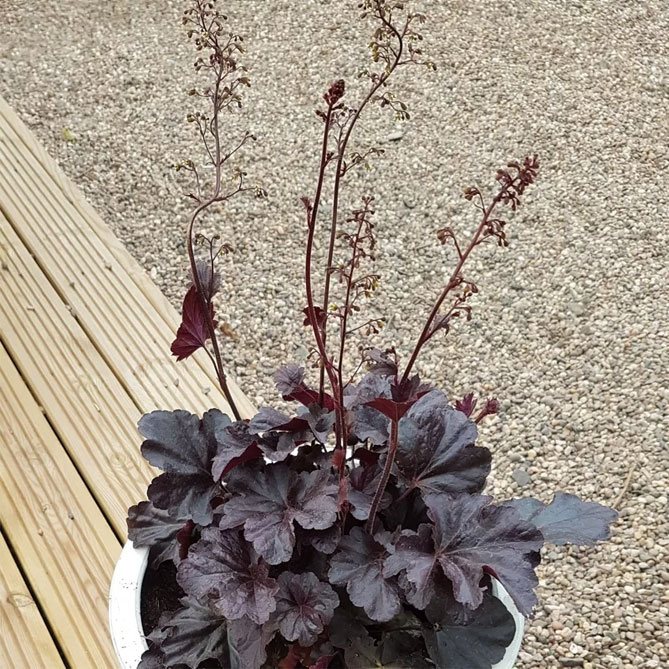

Fertilizer
Heuchera is moderately fertilized from spring to mid-August. It is advisable to use liquid fertilizers such as Florovit every 2 weeks.
Landing rules
Despite the unpretentiousness of the decorative culture, when planting and transplanting Heuchera, it is extremely important to choose the right site and observe the planting technology:
- depending on the varietal characteristics, seedlings of an ornamental culture should be planted in areas with good lighting or with little shading; for a significant part of the varieties, half-shaded places with sufficient lighting in the morning should be set aside for planting;
- the site for planting any kind of geychera must be well protected from stagnant cold air and north wind;
- unpretentious plant grows and develops best on light, nutritious, well-drained and permeable soils.


The distance between the planted plants can vary depending on varietal characteristics, including the size of the aboveground part. After planting, it is necessary to provide the flowers with abundant watering, and, if necessary, shading.
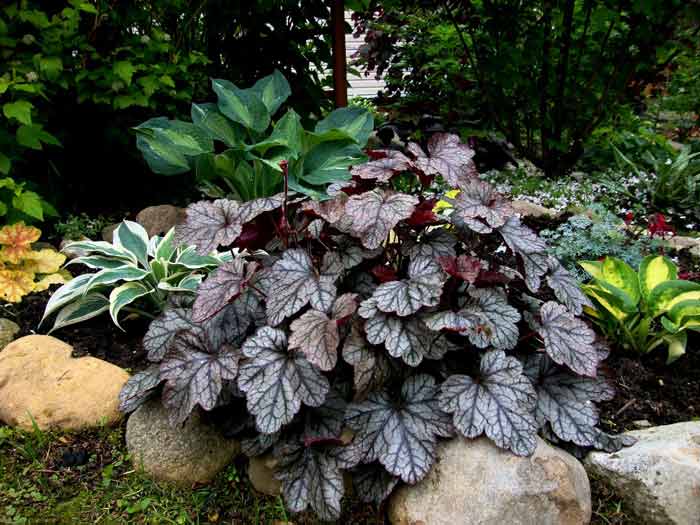

Popular varieties of Heuchera
"Marmalade" - yellow-orange leaves set off the light purple underside, small greenish flowers complement the picture.
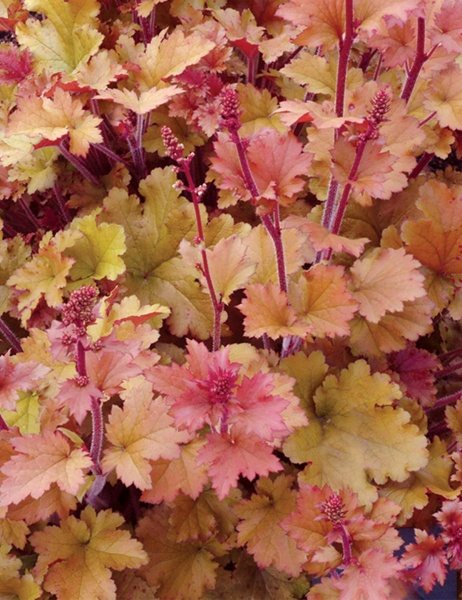

"Caramel" - honey-yellow leaves, as if asking to be eaten, light pink flowers, like roses on a cake.
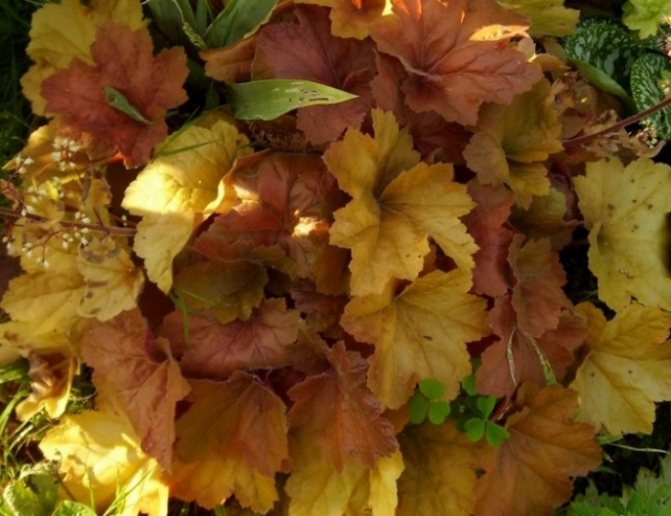

"Purple Castle" - ivy-shaped dark purple leaves, giving a solid severity, shaded by cream flowers in the form of bells.
"Black bird" - dark-burgundy, almost black large leaves, reminiscent of the wing of a raven.
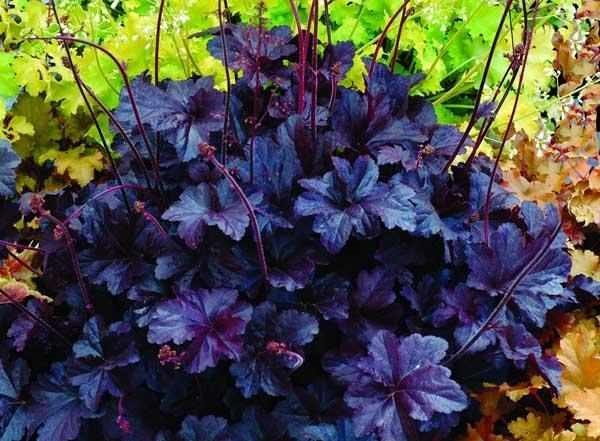

"Cherry Cola" - red-brown leaves and pink flowers, will color any flower bed.
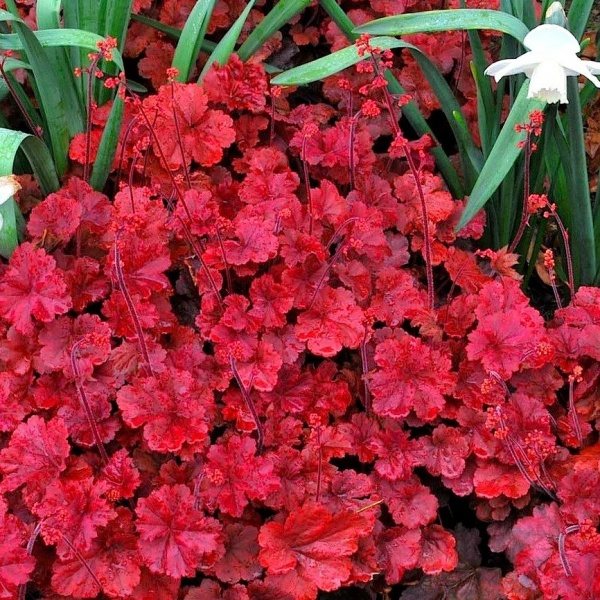

"Lime Pie" - yellow-greenish leaves, and they ask for tea.
"Lemon" - bright yellow leaves, diluted with surrounding greenery, will bring mood to the garden.
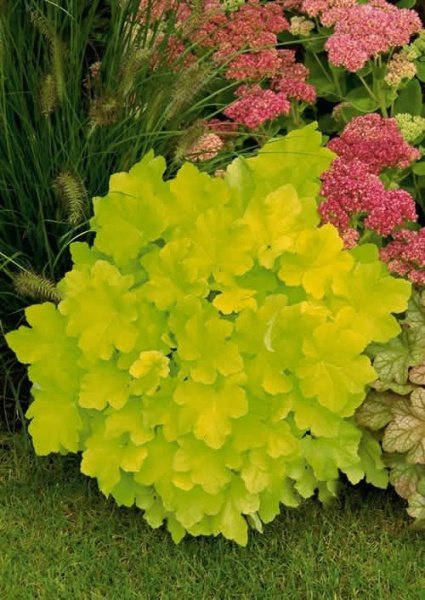

Breeding methods
There are 3 ways to propagate a crop in the ground:
- division;
- cuttings;
- growing from seeds.
During division, special attention is paid to dry shoots and long roots. It is required to preserve live brood buds, which are located in the axils of leaves that have dried up. Thanks to reproduction by seeds, it is possible to get several types of the varieties you like at once. It is better to start sowing in early spring, and to be more precise, in March or April. During disembarkation, the following procedure must be taken into account:
- it is required to prepare the presence of a wide plastic container, which depth is more than 5 cm with drainage holes in the bottom;
- this container is filled with loose soil, which is mixed with large sand or perlite;
- before sowing, you must not forget to spill the soil with boiling water;
- mix the seeds of the culture with fine sand;
- after the ground cools down, sprinkle sand together with seeds evenly over the entire surface;
- the crops themselves are covered with glass or foil.
The container where the seeds are located should be in a sunny place, away from cold and drafts. After the sprouts can hatch, a hole should be ignited in the film, and the glass itself should be raised. Following the appearance of the 3rd leaf, small bushes must be planted at a distance of 6 centimeters from each other.
A beautiful geyhera knows how to create a charming atmosphere of a fabulous lawn on a personal plot.
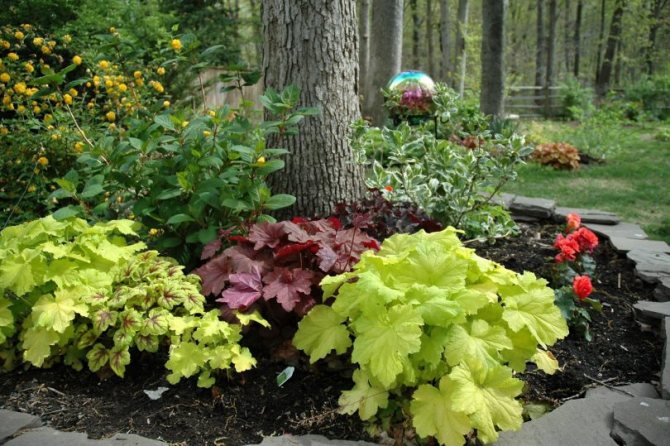

The presence of natural stone, small islands of geychera and a short-cut lawn will create a successful composition to decorate your own yard.
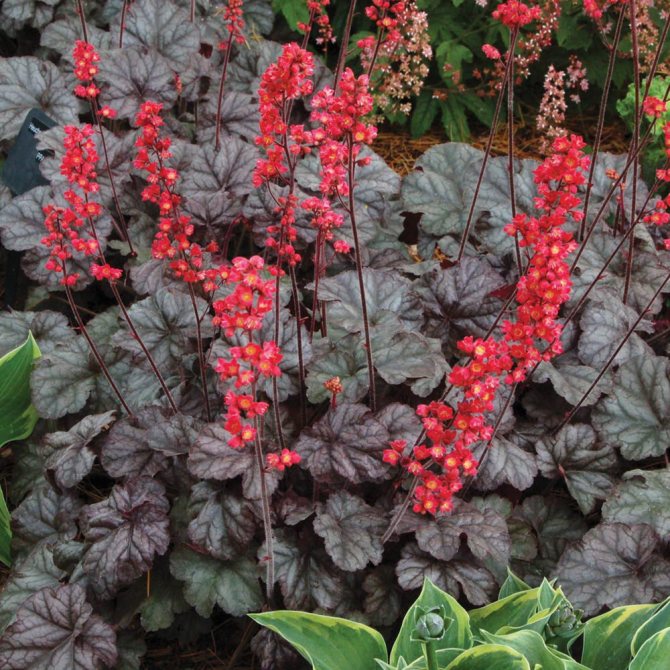

Heichera can grow in pots too. The autumn color of the pleasant plant has yellow-red tones.
Heuchera requirements for cultivation conditions
The temperature of the air or soil has almost no significant effect on the state of the heuchera. The plant can grow both under large large trees and next to small shrubs that form partial shade. In view of this, it is recommended to plant the plant from the east or west side of the site. However, here it is necessary to take into account the specific features of the culture. Thus, plants with a bright and rich foliage color require stronger sunlight. Heuchera with red foliage (Heuchera Regina, etc.) under conditions of shade changes color to green.
The culture is not very demanding on the choice of soil, however, it grows worst on acidic soils. The optimal pH for a given plant ranges from 5-6. Heuchera also reacts negatively to stagnant water in the root zone, which is why it is necessary to organize a drainage system on the site.
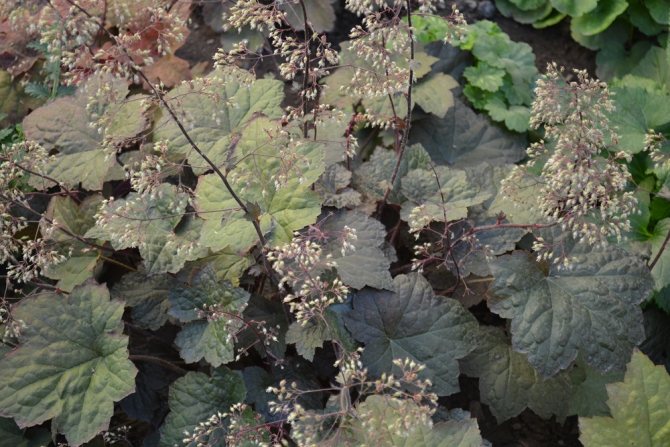

Heuchera requirements for cultivation conditions
When to plant Heuchera in open ground: timing
The optimal time for planting Heuchera is Springwhen the soil has warmed up enough, the weather has stabilized, and the threat of return frosts has passed, that is, for the Central strip (Moscow region) - this is approximately the second half of May-early June.
Can be planted and in the fall, but not very late (in late August - early September), so that the plant has time to take root before the first frost (it takes a little more than 1 month for rooting on average).
In principle, it is allowed and summer landing of heuchera (necessarily with an earthen clod and followed by shading after planting), but in fact, container plants can be planted all year round.
According to the lunar calendar in 2019
It can help you to choose the optimal date for boarding. Moon calendar.
So favorable days for planting geychera in 2019 according to the lunar calendar are:
- in March - 12-17, 19, 20, 27-30;
- in April - 6-8, 11-13, 15-17, 24-26, 29, 30;
- in May - 6-8, 10-17, 21-23, 26-28, 31;
- in June - 1, 2, 5, 6, 9-13, 16-20, 27-30;
- in July - 8-12, 25-31;
- in August - 2-6, 17, 18, 21-23, 26-28;
- in September - 1-5, 7-10, 17-24;
- in October - 4-7, 9-12, 19-21, 23-25, 27;
- in November - 13-18.
Unfavorable days according to the lunar calendar for 2019 for the landing of Heuchera the following dates are
- in March - 6, 7, 21;
- in April - 5, 19;
- in May - 5, 19;
- in June - 3, 4, 17;
- in July - 2, 3, 17;
- in August - 15, 16, 30, 31;
- in September - 14, 15, 28, 29;
- in October - 14, 28;
- in November - 12, 13, 26, 27.
According to the lunar calendar from the magazine "1000 Tips for the Summer Resident".
Autumn care and wintering
Heuchera does not require special care. In autumn, after the end of flowering, you need to remove the peduncles. Do not cut dry stems and leaves. They are necessary to cover the root system during wintering. The plant may not tolerate severe frosts. Therefore, for the winter, it is additionally spud with dry foliage, straw. The soil around is mulched with bark and ash. In the spring, when the weather is warm, the shelter is removed and the stems are carefully cut as close to the soil surface as possible.
How to care for open field geychers
In caring for a Heuchera, you should always adhere to the golden mean, in other words, it needs moderate watering, reasonable feeding and, as already mentioned, partial shade places.
Watering
Heuchers need moderate watering, in other words, the soil should be only slightly moist. Due to excessive dampness, the plant begins to ache and rot. However, it also reacts negatively to drought.
Heuchera varieties with silvery leaves are considered the most drought tolerant.
However, if you planted Heuchera in the sun, then in such conditions they will need more abundant and frequent watering.
Top dressing
Heuchera should be fertilized only in cases of increased need, because initially the plant grew in conditions (in the mountains) where the land can hardly be called fertile. Therefore, heuchera does not require regular feeding, it can grow well without them. If the appearance of the plant is depressing, and you have already changed the place several times (i.e.that's not the point), then you still need to feed. But, as many experienced gardeners recommend, it is better not to feed it than to overfeed it.
Diseases and pests
The plant very rarely gets sick and is almost not affected by pests (theoretically, when waterlogged, slugs and snails may appear on the leaves, but there are no real facts and reviews about such a problem), but with excessive diligence in care (overflow, overfeeding) it can pick up powdery mildew (for treatment you can use - Fundazol, Topaz), rust or some kind of stain (Bordeaux liquid solution).
Winter preparation and spring care
Due to the peculiarities of its structure, the plant suffers especially during the period of snowless frosts, therefore, in the fall it is recommended to mulch it with peat, compost, sawdust, oak leaves or coniferous litter.
Advice! It is recommended to initially bury the seedling in the ground so that its buds are not too high on the surface and, therefore, do not freeze.
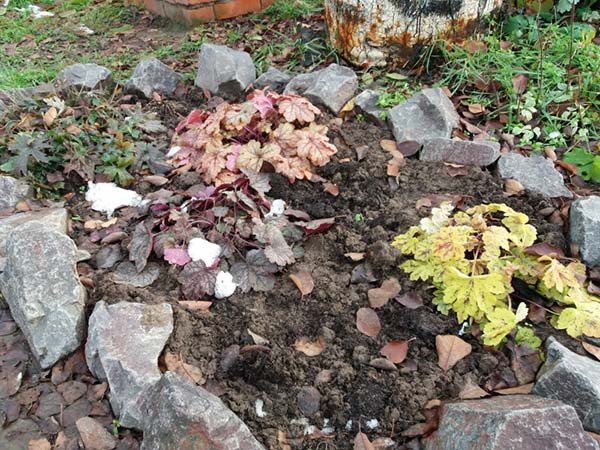

Also for the winter, the plant should be covered with spruce branches from the spring sun, although this can be done in early spring.
If you built a shelter, then in the spring it should be removed only after the soil has completely thawed.
In general, heuchera is a very winter-hardy plant (in the Middle Lane, its maximum needs only to be mulched and covered, more precisely, to close it from the spring sunlight).
Video: how Heucheras winter - their preparation for winter
It is also worth knowing that leaves leave in autumn (this is like a natural shelter), and cut them in the spring, and only those that for some reason (for example, burned down in the spring) died (became dry).
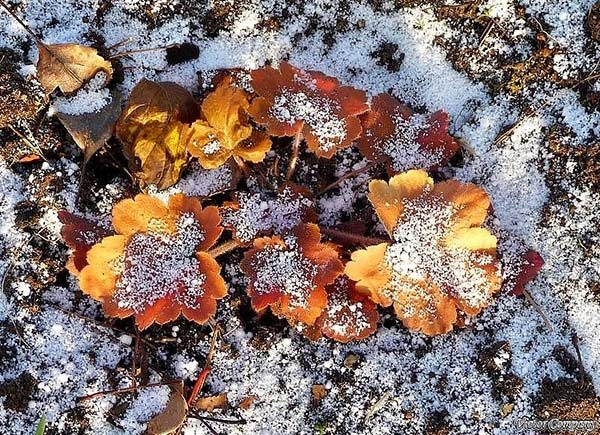

Interesting! Yes, heuchera leaves easily survive the winter and do not fall off.
Although it should be said right away, different varieties tolerate winter in completely different ways: for some, the leaves simply burn out from the spring sun (the leaves cannot evaporate moisture, because the root system is still frozen, which is why they burn), so they are needed will definitely cut. Others remain decorative even for the next year, but it is still recommended to cut them (last year's leaves).
Video: caring for Heuhera in the spring
Growing rules
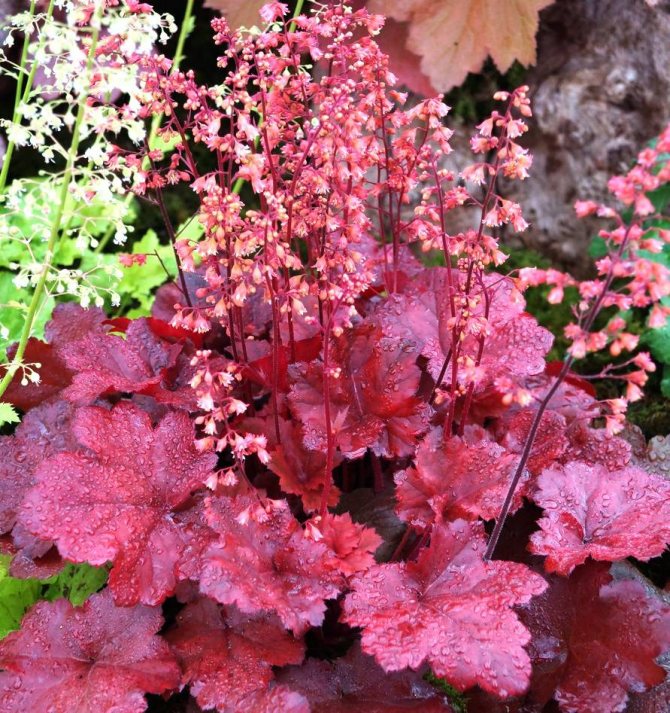

Decorative flowering variety
Despite its unpretentiousness, some care features are still available. In particular, you should get rid of peduncles if you have a decorative deciduous variety, otherwise they begin to rise above the flower and this phenomenon looks very ridiculous. It is recommended to leave peduncles only in one case, if you need seed material.
The lower foliage of the flower tends to fall off over time, so that there are no noticeably naked ugly stems, it is recommended to carefully transfer the flower to another place deeper before flowering, without shaking off the roots from the soil. It should be mentioned that this flower prefers to grow in the neighborhood of primrose or astilbe.
Breeding methods
There are several ways to breed Heuchera:
- dividing the bush;
- cuttings;
- clonal micropropagation;
- seeds;
- sheet.
The simplest and most common are division and cuttings.
By dividing the bush
The procedure for dividing a plant to obtain seedlings has the following sequence:
- Heuchera is dug up.
- Shake and wash the roots.
- Divide the plant into 2-3 parts.
- Cut off dry or damaged leaves.
- Remove rotten roots.
- Containers for seedlings are equipped with drainage.
- Delenki are planted in a substrate for seedlings.
- Water the plants at the root.
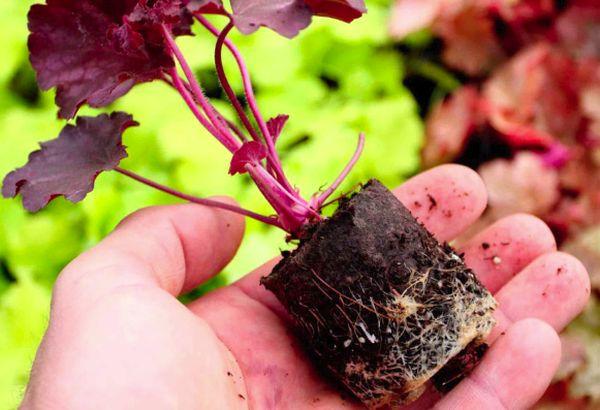

Cuttings
Pre-planting cuttings of Heuchera are carried out in this way:
- The rosette is cut from the plant along with part of the rhizome.
- Remove dry and rotten parts.
- Sections are treated with wood ash.
- Containers for seedlings are equipped with drainage and fill the soil.
- Shallow holes are made in the ground.
- The cuttings are lowered into the ground so that the rosette remains above the ground.
- Water the seedlings at the root.
Varietal and species diversity
Different varieties and types of hostas differ markedly from each other in size, shade and leaves. The following categories are distinguished:
- tall. Reach from 60 to 85 cm.Used as a tapeworm against the background of decorative styling,
- undersized. Height no more than 40 cm.Popular planting site - containers and hanging pots,
- medium-sized. The plant is from 40 to 60 cm high. They are used for landscaping flower beds, sometimes they grow on water,
- ground covers. Creeping plants adorn an alpine slide or artificial rocky slope. Height does not exceed 20 cm.
Heuchera is conventionally divided into 2 types, but it has more than 400 varieties. The most commonly used:
Forest:
- American geyhera,
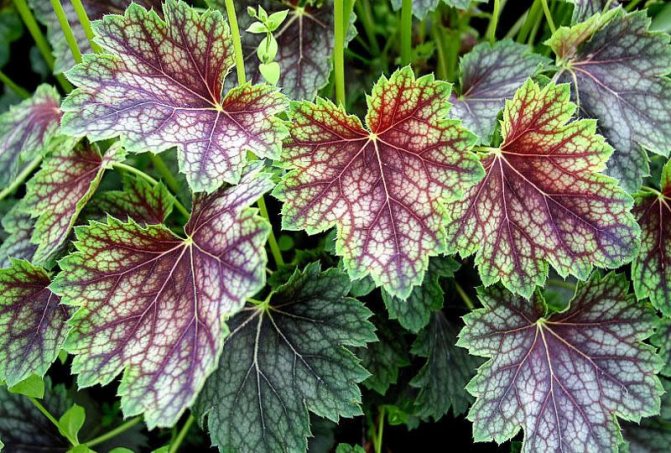

- heuchera hairy,
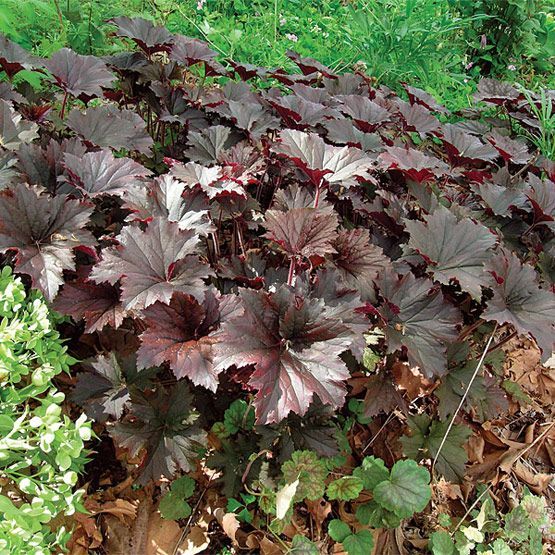

- geychera small-flowered.
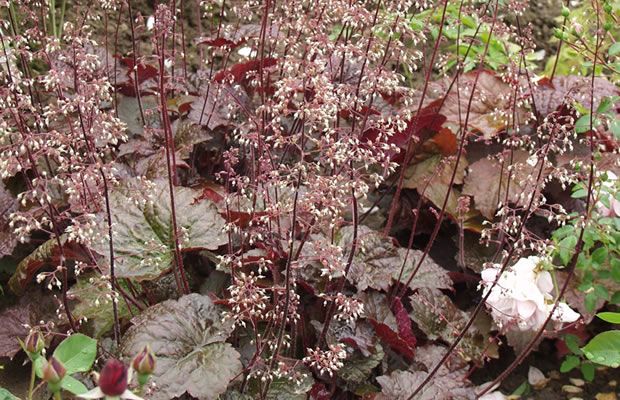

Mountain:
- heuchera cylindrical,
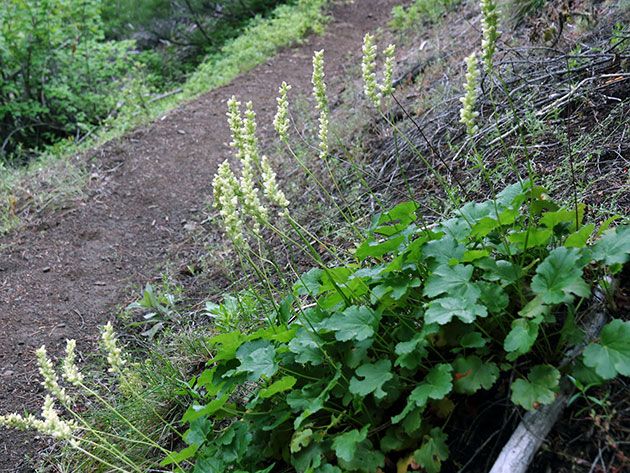

- geykhera blood red,
- Heuchera is hybrid.
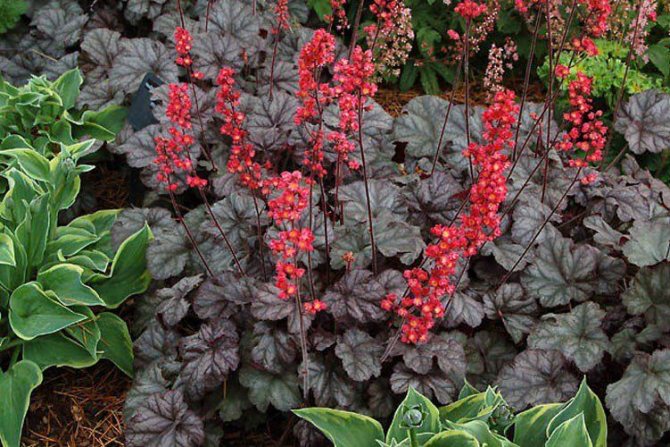

Botanical features
The decorative culture was named after the famous German botanist Johann Heicher. Known botanical description and characteristics of about sixty plant species belonging to the genus Heuchera. Many of them grow only in North America and Mexico. Some varieties are found in mountainous areas and coastal areas.
Usually, plant height does not exceed 0.5 m. Root-type leaves, long-petiolate. Heuchera foliage amazes with a variety of shades and can be not only classic green coloration: there are species with white, cream, red, purple, brown, gray and silver leaves. Flowers are numerous and small enough, collected in paniculate inflorescences. The flower, depending on the variety, can have a red, pink, greenish or whitish color.
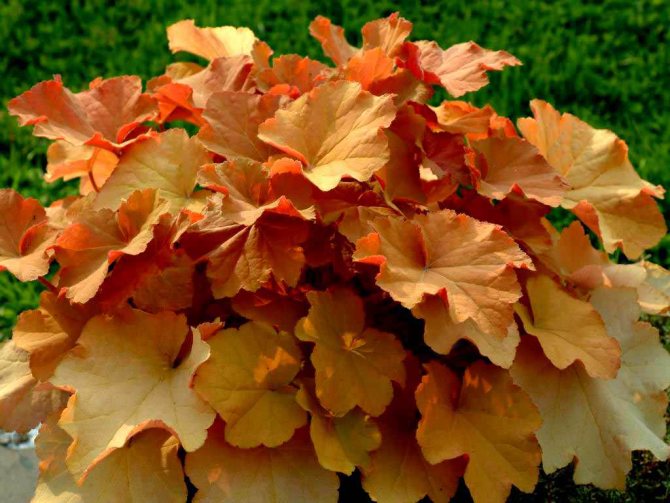

Care
The technology of care is not complicated, everything is the same as for other plants in the flower bed. Provide regular watering as the soil dries. It is important that the water does not get on the leaves, especially if you water during the day. If you do not adhere to this rule, burns may form on the leaves. The approximate consumption is a bucket for 2 days. In the spring, it is worth mulching with peat or sawdust.
A very large and cozy courtyard with a decorative path lined with heuchera bushes and other plants
Snails, slugs, caterpillars, leaf nematodes are dangerous for Heuchera. If the plant is not properly cared for, gray rot, rust, powdery mildew, and spotting may develop.
You can feed, but not necessarily. Period - before and after flowering, the dose indicated on the package should be reduced by 2 times. Fertilizer - complex, mineral.
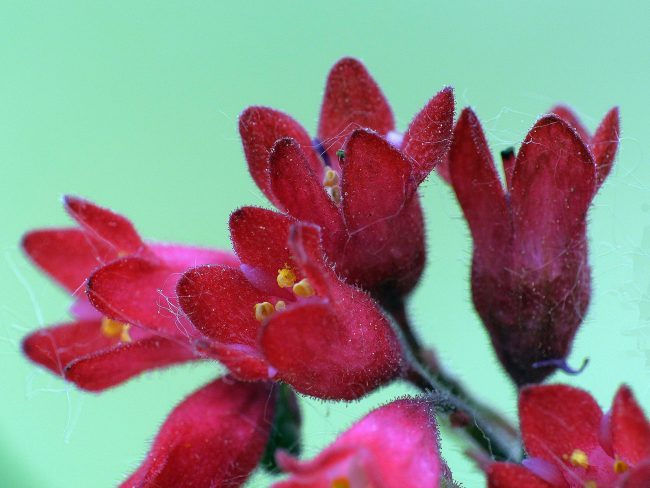

Closeup of rachel cultivar Heuchera flowers
Important! If you do not plan to collect the seeds, after flowering, the stems of the peduncles must be cut off.
Heuchera alba with delicate white blooms and bright green leaves
The plant overwinters in the garden, the leaves, as already mentioned, cannot be cut off, but it is still better to keep the roots warm. In order not to freeze Heuchera even in the most severe winter, it must be covered with leaves, preferably oak leaves. With the arrival of spring, the shelter must be removed.
Having planted Heuchera in the fall, you should take care of proper care, if the climate is harsh, then you need to cover it in early spring, you can use agrofiber for this.
Propagation of heuchera by cuttings
Cuttings of Heuchera photo
The second breeding method is cuttings.
- In June or July, you need to cut the stalk so that it does not touch the rhizome.
- It is better to treat the cut site with a root former, the leaves are not needed at the bottom, they can be removed, and after that, the finished cutting can be planted in peat or sand.
- For good growth and rooting, it will take 2-4 weeks, with constant soil moisture, airing the greenhouse.
Growing problems
One of the most common problems of an adult plant is freezing of the roots. This is due to the desire of the roots to leave the ground.They become naked and vulnerable to disease and frost. To avoid this, you should periodically pour soil under the bush so that there is always a small mound along the contour of the roots.
Geichera is one of the most unpretentious garden plants Source
Another common problem is root rotting as a result of stagnant moisture in the soil with insufficient drainage layer. When the soil in the garden is clayey and excessively moist, heuchera should be planted in a bulk flower garden or flower bed with an optimal soil for the variety, or plant it in a separate container. If the bush has developed well, and rot has appeared only recently, it is time for the plant to rejuvenate. The dead fragments of the rhizome should be removed, the bush should be divided, and when planting new plants, arrange for effective moisture removal.
Some varieties of geyher begin to age early. At 3-4 years of age, the upper shoots are lengthened so much that the root system is no longer able to supply them with a sufficient amount of nutrients, the stems fade and dry out quickly.
In this case, the roots should be divided. The plant is dug up, the dead fragments are cut off to healthy buds, the root is divided into several elements, which are planted. A bush rejuvenated in this way will grow for several more years, then the procedure must be repeated, or it is not timely to remove part of the processes.
On wet soils, Heuchera is planted in a small container Source cstor.
Briefly about the plant
The bush is densely assembled from leathery toothed leaves protruding from long cuttings.
The color of heuchera leaves can be different: black, bright red, maroon, amber, pink, purple, yellow, green and silver. They can also be covered with patterns, veins, specks and specks. The leaves of the plant are smooth, corrugated and curly. The flower blooms in early summer and blooms before the first frost. The plant has small pink, cream, or red bells that gather in panicles. Seeds ripen in the heuchera box, which can be planted in the ground for the purpose of plant propagation.
Transfer
For some species, a Heuchera transplant is required every three years. The plant retains its outlet for no more than five years. Then the bush exposes the entire middle. You can transplant the plant in autumn or spring. To plant a plant, you need to do the following steps:
- After flowering, remove peduncles and bare stems. The plant blooms from June to August. Her flowers are small. The color can be cream, white, red, bloody, purple. The flowers look like bells. They are collected in panicles. The fruit of the heuchera is a box containing the seeds. They are about the size of a poppy seed.
- Dig up an old bush and divide it into several pieces.
- Place the received divisions according to the selected places.
Plant characteristics
Heuchera is an ornamental plant that is a composition of toothed leaves. It is popular for the various shades of these leaves and the ability to maintain a presentable appearance until late autumn. At the moment, there are over 70 varieties that are able to fit into any landscape. All of them are divided into forest and mountain ones.
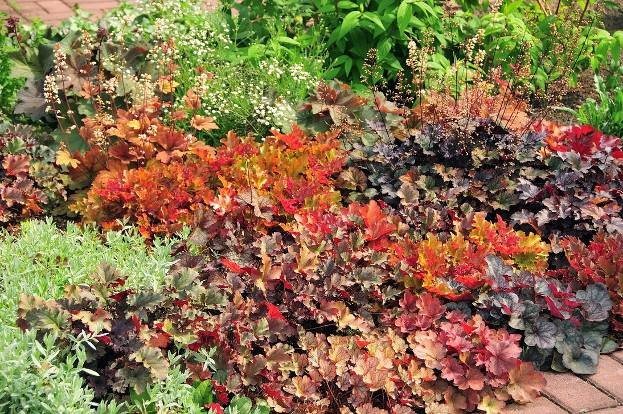

Important! This plant is distinguished by its unpretentiousness, which will be an undoubted advantage for those who have no time to carry out full-fledged care of flower beds.
Heuchera is appreciated by both beginners and professionals for the following qualities:
- The ability to create a bright accent on the site.
- Maintaining an attractive appearance throughout the season.
- Good survival rate in containers.
- The ability to adapt to any light saturation.
- Good transfer of cold weather and temperature fluctuations.
- Simplicity and fast reproduction time.
- Resistant to the most common diseases.
- Undemanding care.
- Acceptability with most other plants.
- The possibility of landing near ponds and on stone compositions.
Due to the variety of varieties that differ in appearance, Heuchera can be used to decorate rockeries, rock gardens, multi-tiered flower beds and other plantings in the foreground.
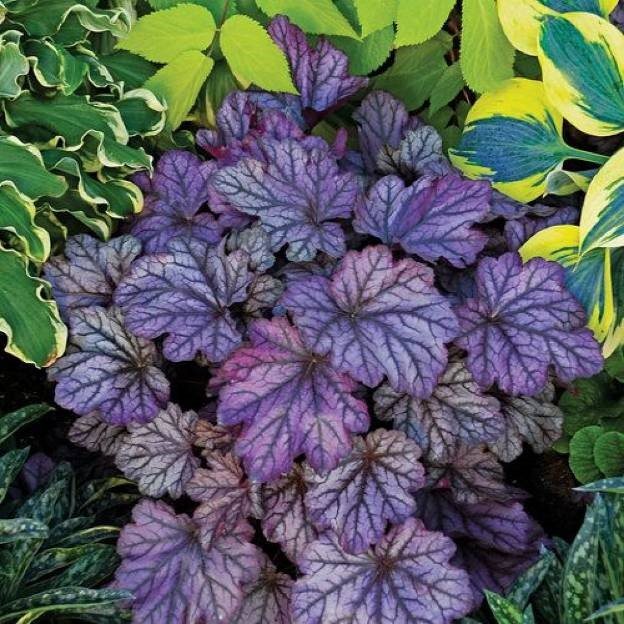

Features of growing from seeds
Heuchera seeds are propagated relatively infrequently, but this method is relevant for rare varieties for breeding purposes. Using it, you can get more plants in one season than by dividing a bush. It is important to take into account some of the features of seed reproduction, namely:
- The seeds will sprout no later than 6 months after harvest. If the package is sealed from foil, then 18 months.
Heuchera peduncle is cylindrical with pronounced green leaves with characteristic dark spots along the veins
- The soil should be loose; it is advisable to add fine-grained sand or perlite.
- Before sowing the nutrient mixture, you need to warm it up in the oven, so all harmful organisms from the soil will be destroyed.
- You need to sow in a well-moistened loosened soil.
- Before pecking the plants, the container should be covered with foil.
- The first shoots appear in 2-3 weeks.
- As soon as the third leaf has appeared on the Heuchera, each plant must be transplanted into an individual container.
- Before planting in a permanent place, young plants need to be hardened for 7 days.
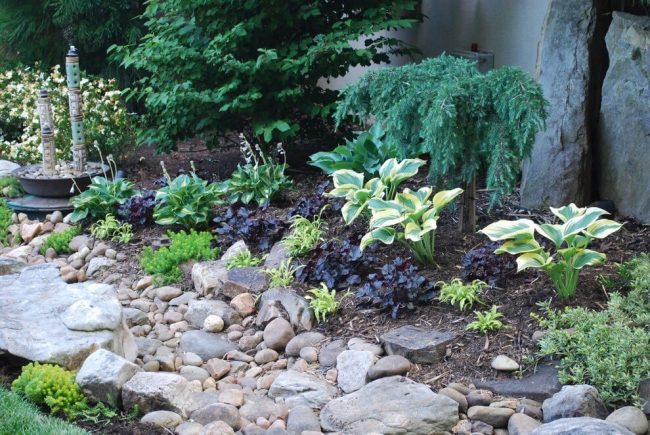

Young Heuchera seedlings in a decorative corner in the courtyard of a private house
What happens after flowering
Usually, flowering lasts the first two months of summer (below are photos of Heuchera flowers), then, when it stops, it is advisable to cut off peduncles with withered flowers.
It is not recommended to cut off spoiled leaves, since throughout the winter heuchera in the garden, it is the yellowed leaves that will ensure the preservation and maintenance of heat at the roots.
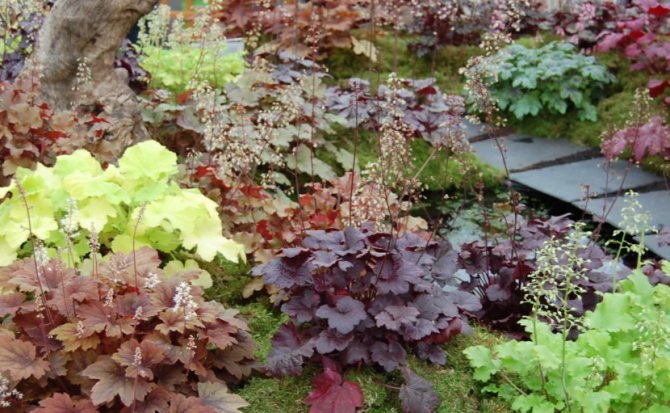

It is advisable to use a shelter made of oak leaves in winter; with the onset of spring, the shelter must be removed.
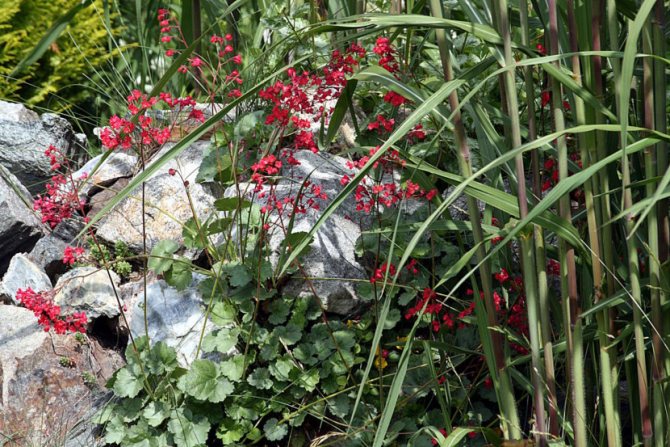

- Bacopa - description of the species, cultivation, care, reproduction + 74 photos
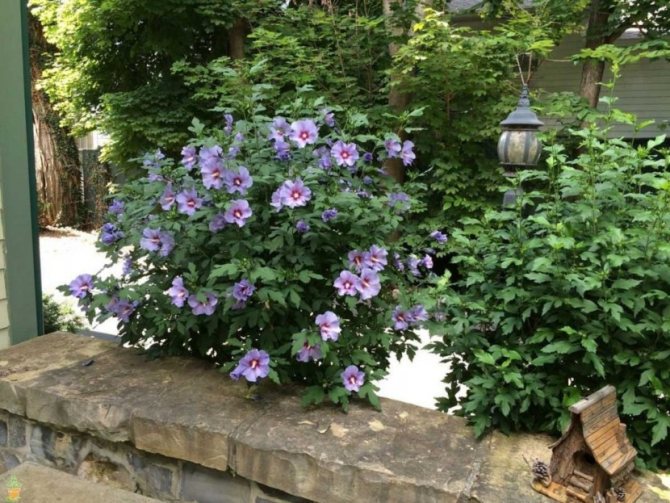

Garden hibiscus - types, description, planting, care and reproduction + 69 photos
- Celosia - growing from seeds and seedlings, planting in the ground and care rules + 80 photos
Popular varieties
Thanks to the ability of the plant to change the color of the leaves throughout the season, an attractive atmosphere always reigns in the garden. Usually, the leaves are lighter in color at first, and darker towards the end of flowering. Often summer residents at the end of the season collect the leaves of this plant and, combining with others, decorate their house with it, putting it in a vase. For a better understanding of what this plant is, consider its types.
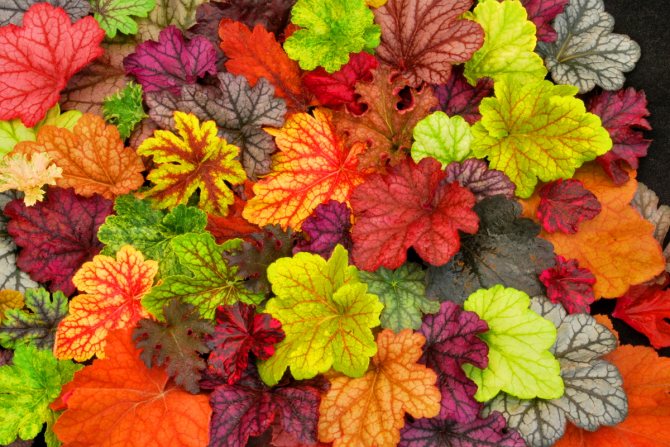

Blood red
This plant belongs to the varieties of the mountain type, is distinguished by high indicators of endurance and unpretentiousness. The bush consists of dense round leaves with carved edges. Its appearance is suitable for landscape design, which has light cream-colored spots on the foliage surface. This heuchera blooms with small bell-shaped flowers of red or pink color.
Important! The plant has medicinal properties.
Small-flowered
This type of plant is especially loved by landscape designers due to its chic appearance. The leaves are similar in design to maple leaves, their shades may be different. For example, bronze or purple, some have silver spots. The flowers are distinguished by a large number and a beige-pink tint.
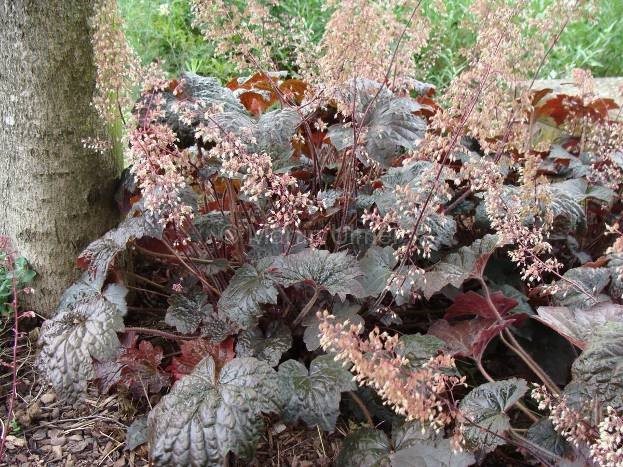

Hairy Heuchera
This variety is forestry. The main feature of the plant is large leaves with a velvety coating and gorgeous peduncles. The flowers are usually in delicate cream or light green hues.
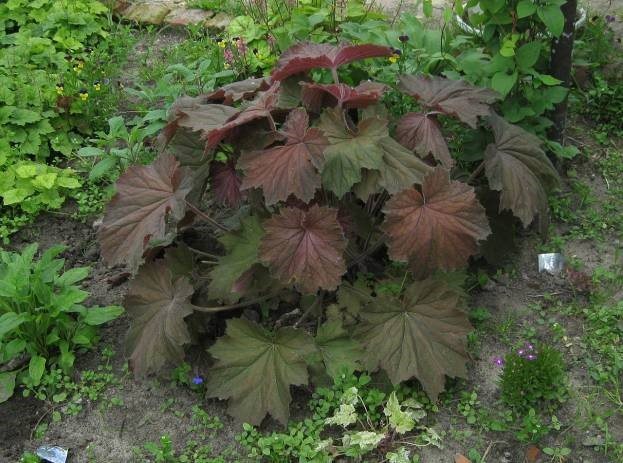

Cylindrical Heuchera
It is a subspecies of a mountain-type plant.It differs in larger sizes than all other mountain representatives. Heuchera got its name due to the inflorescence, which resembles the shape of a cylinder. Varieties of this type are distinguished by a wide range of flower colors.
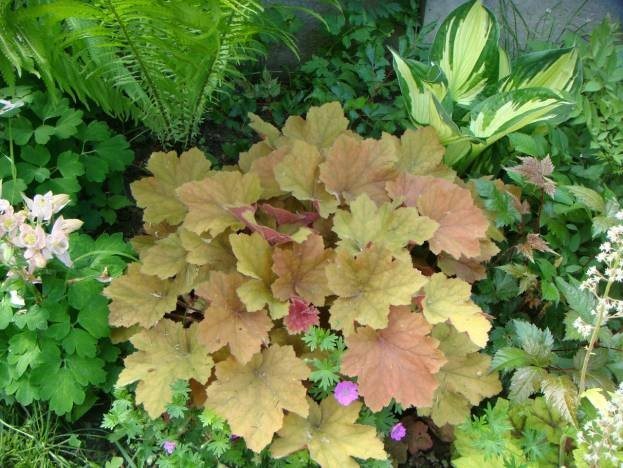

Gooseberry Heuchera
The plant is supplied with small leaves with three or five lobes. But at the same time, they are always collected in groups. Heuchera stems are long, reaching 60 cm in height, at the ends there are medium-sized white flowers.
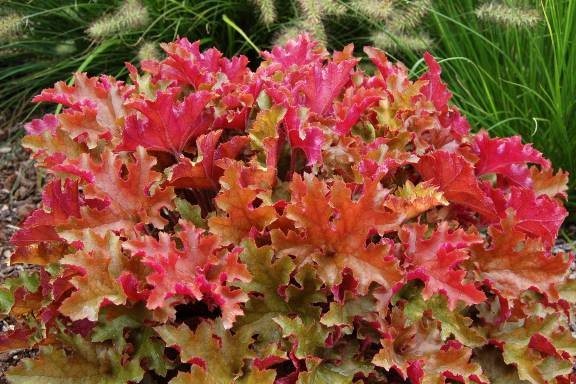

Hybrid Heuchera
The name speaks for itself and means that this plant variety consists of several. In the creation of landscape design, all possible shapes and shades are used that are found in hybrid heuchera. The flowers of the plant also have different colors, which is an indicator of the popularity of the plant.
There are many more varieties of this amazing plant, but we have presented only the most popular. Among the entire assortment, it is easy to choose exactly the plant that ideally complements the personal plot.
